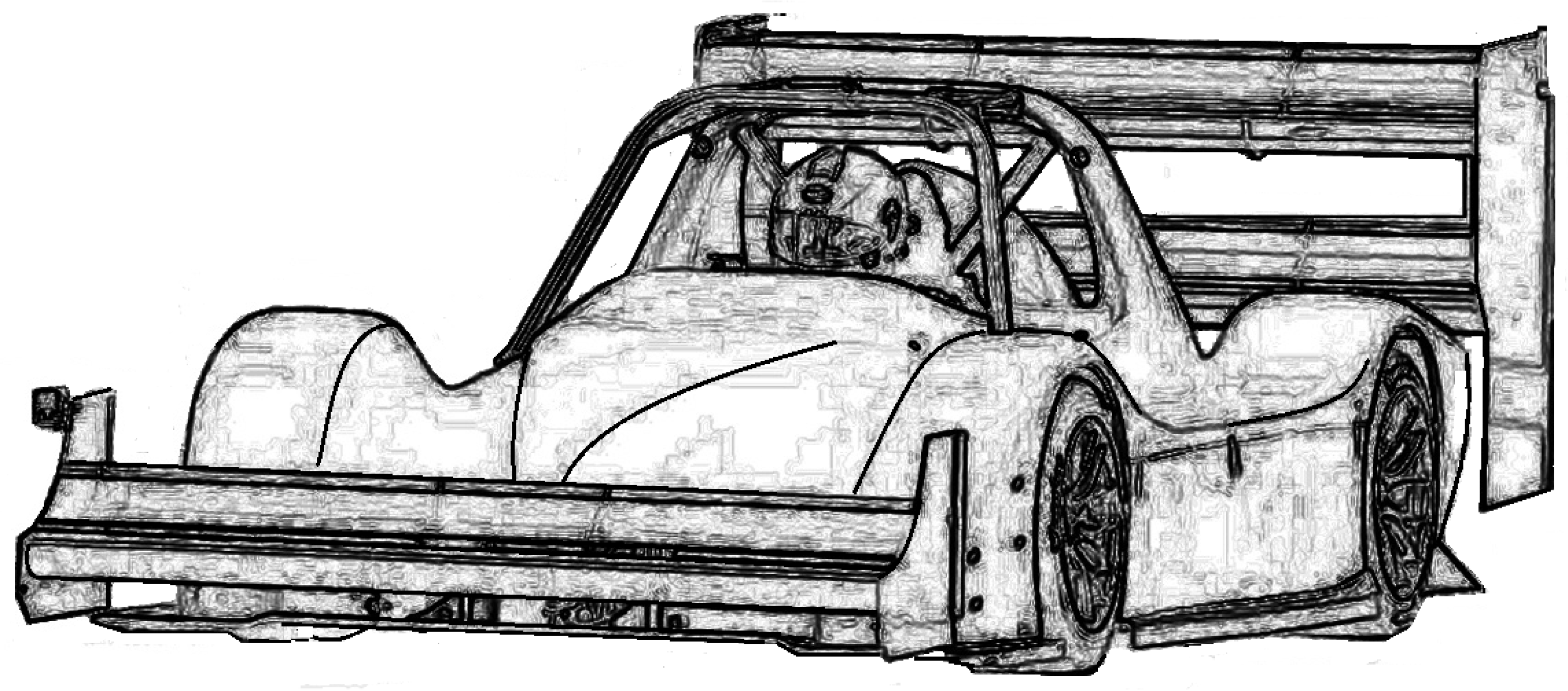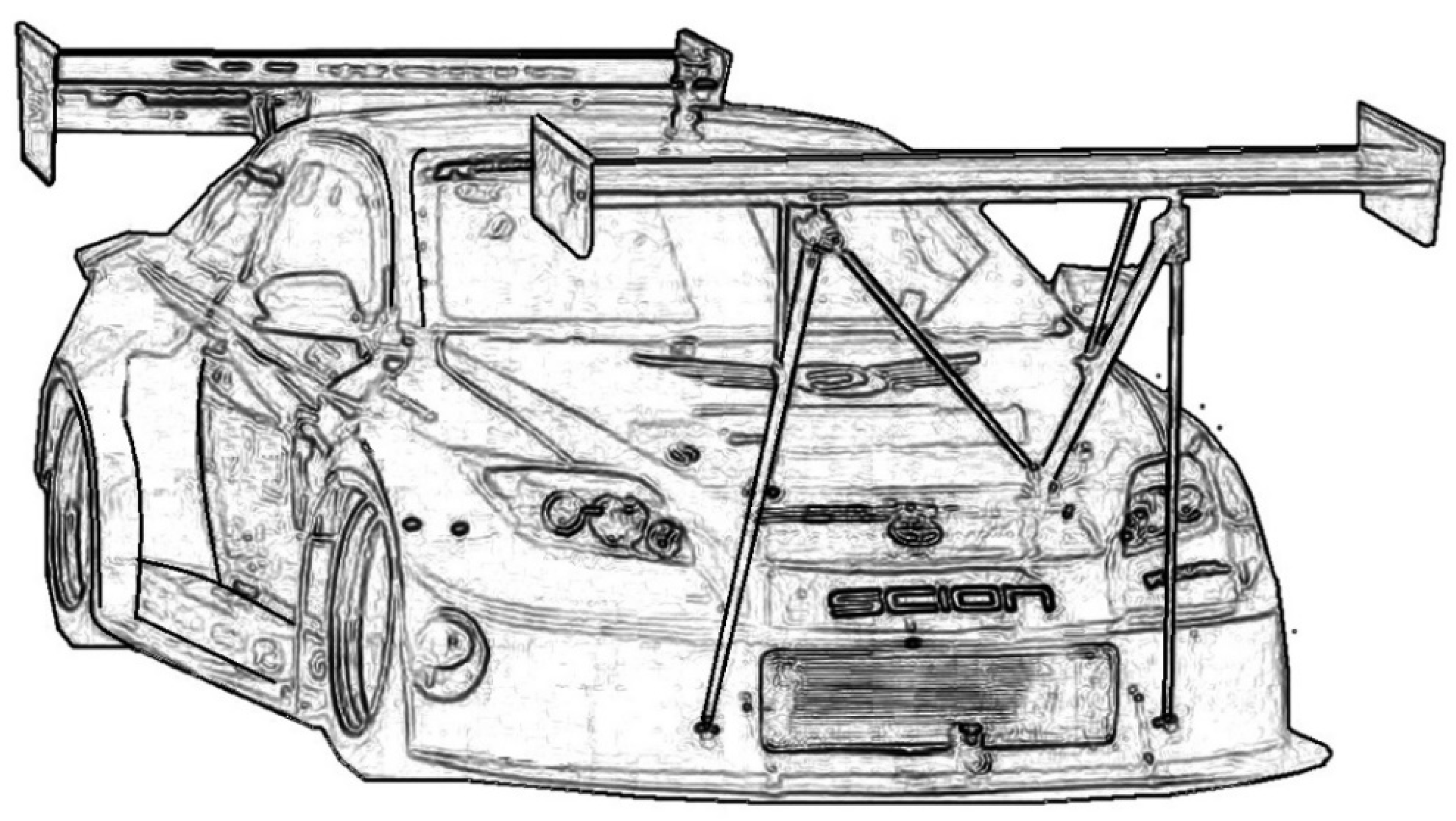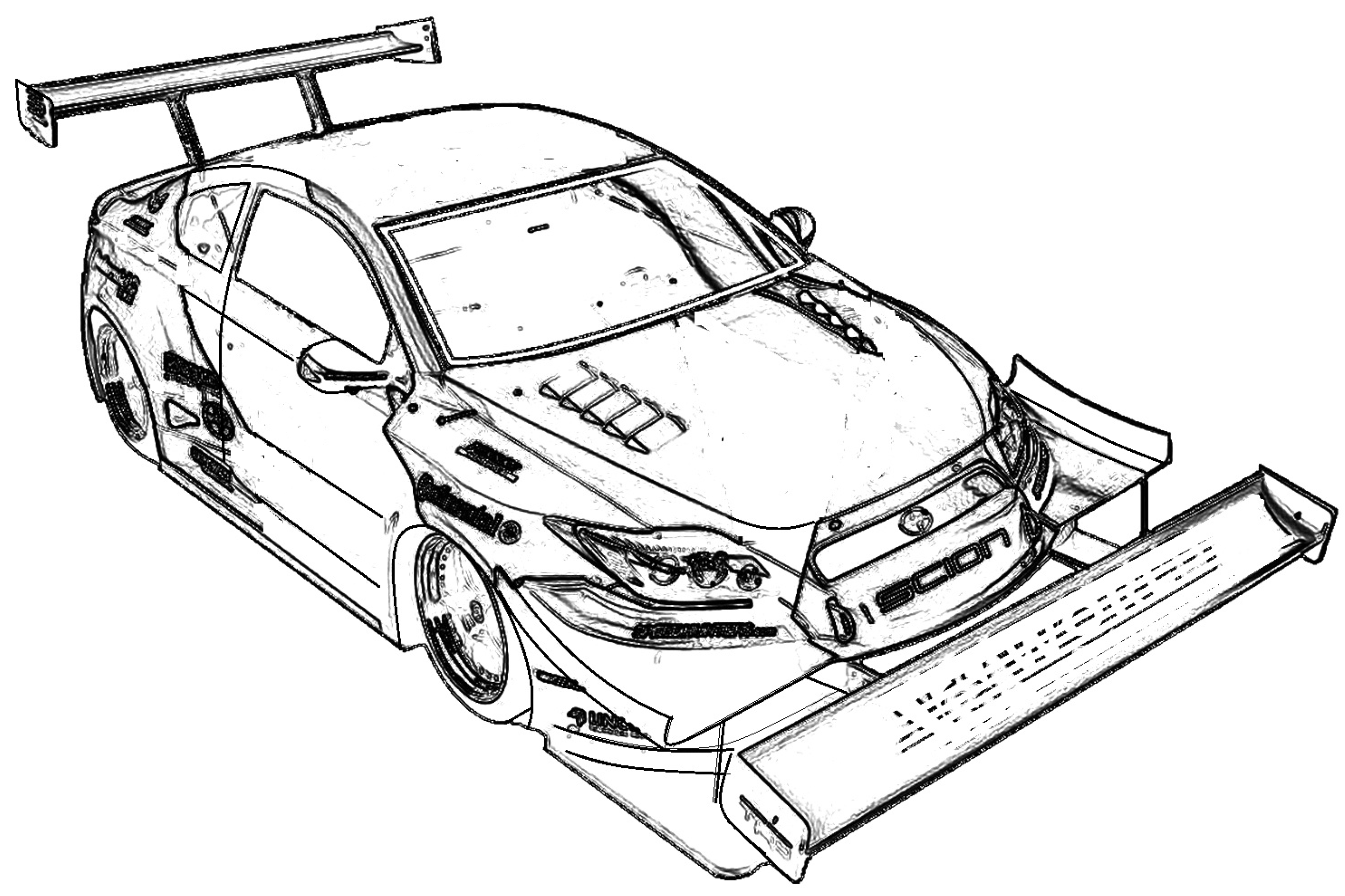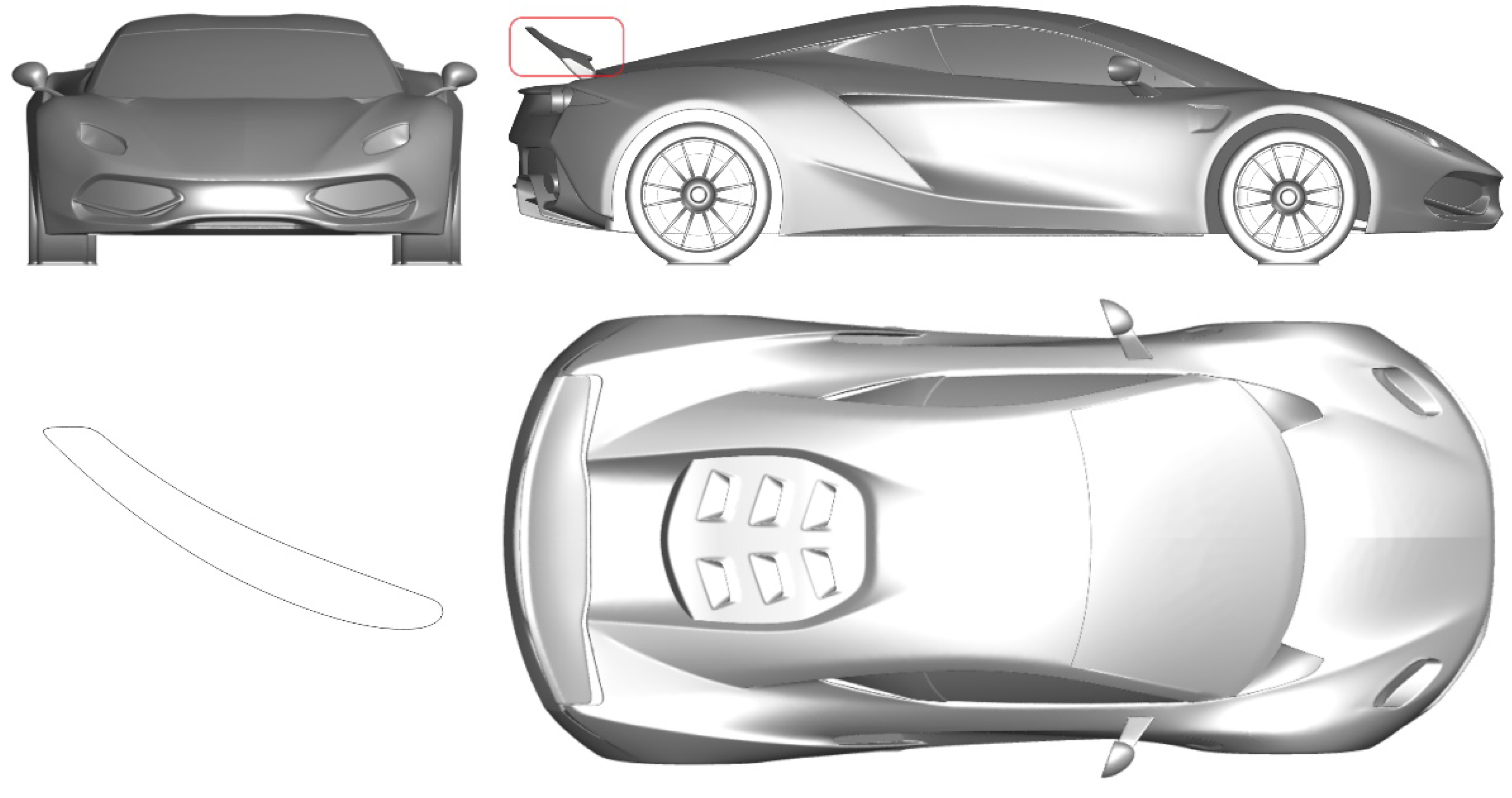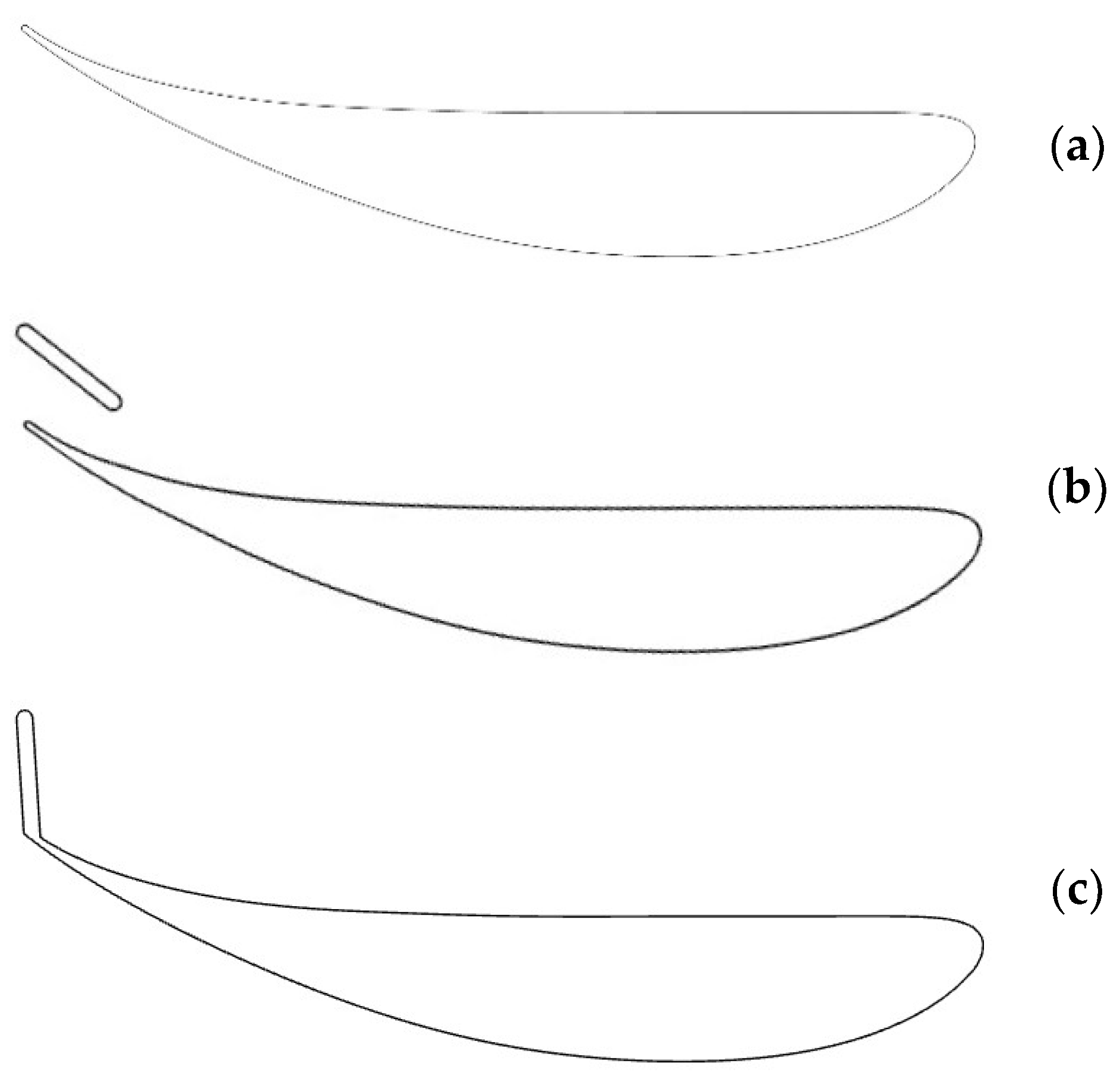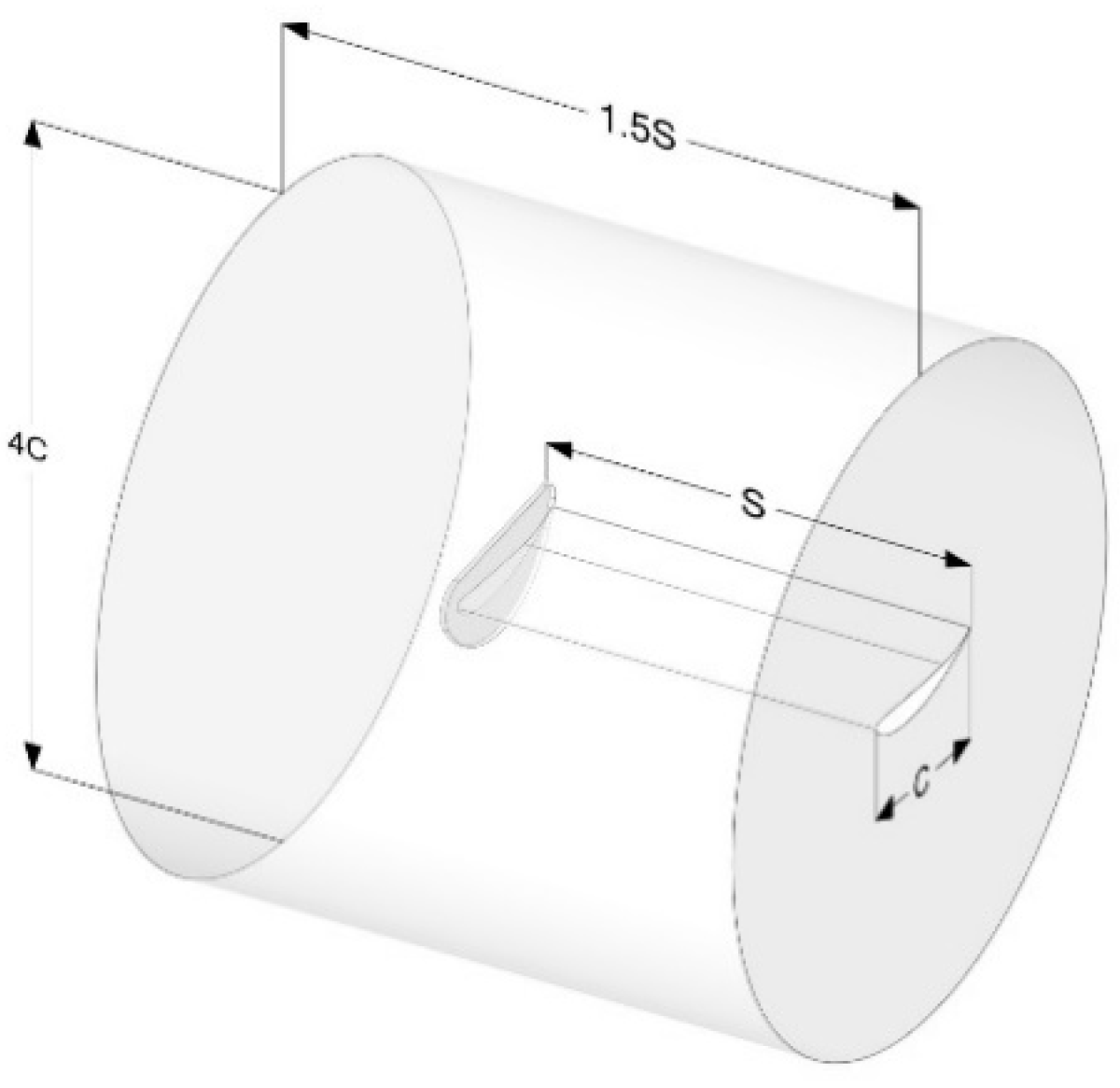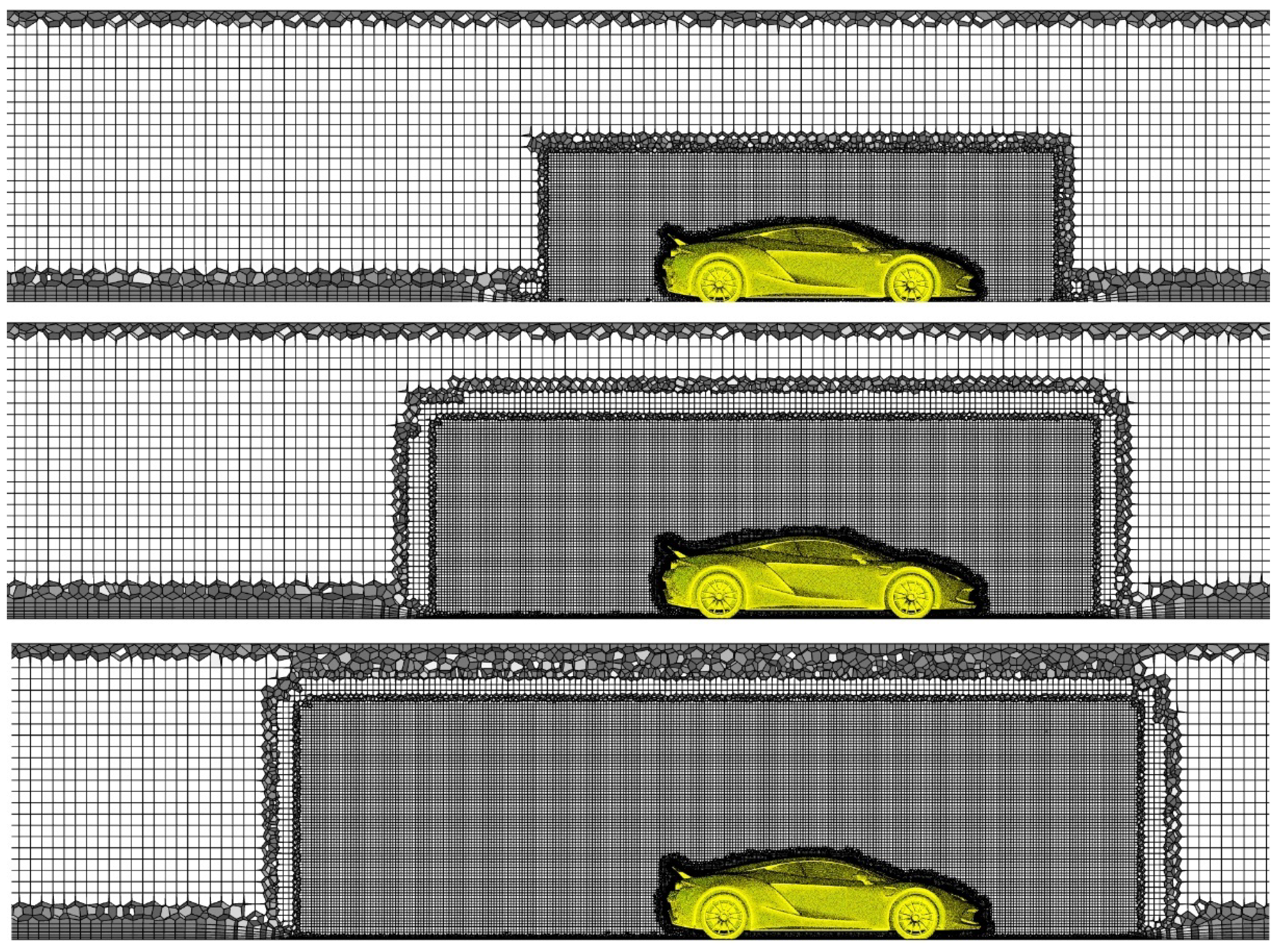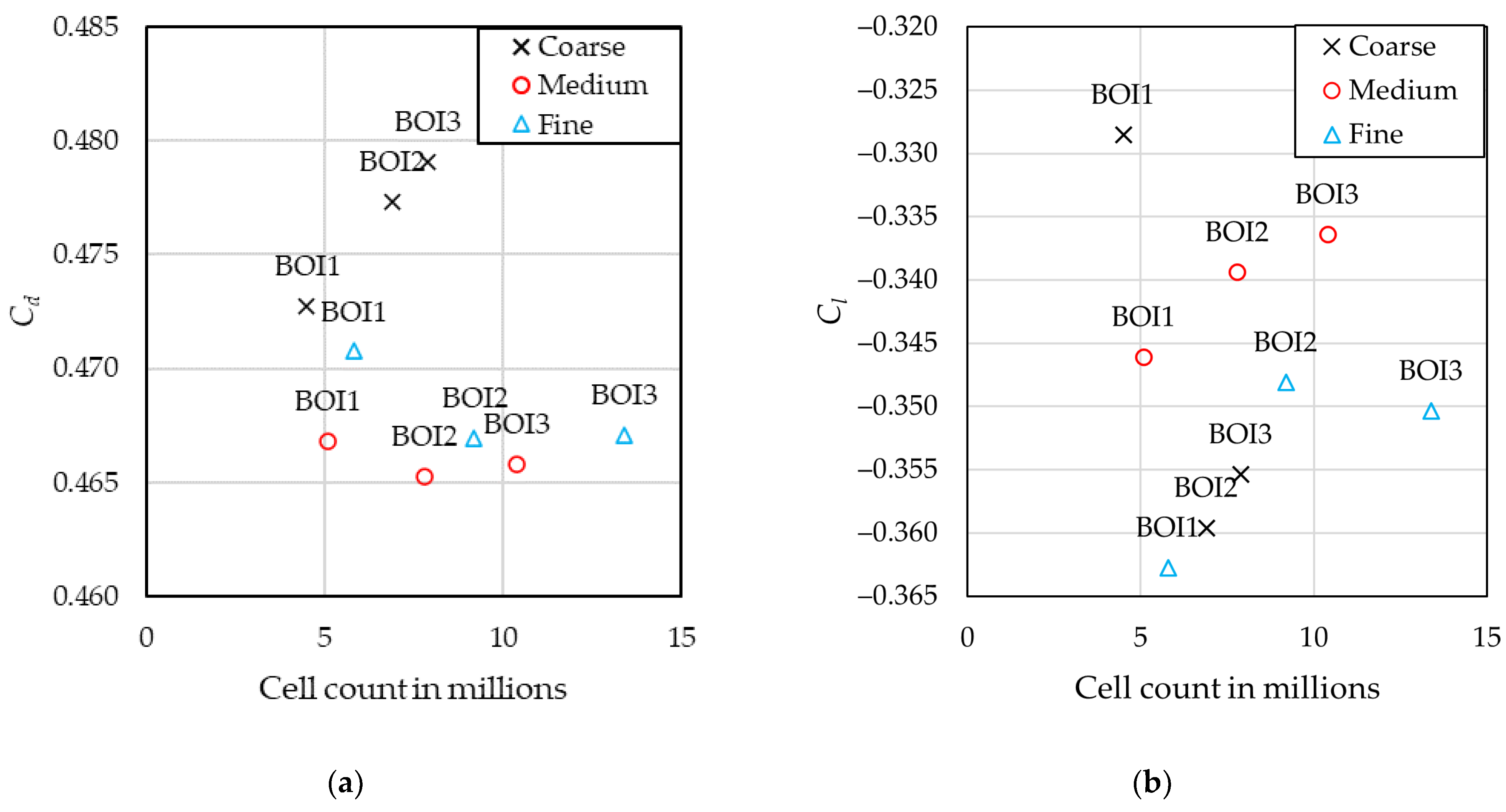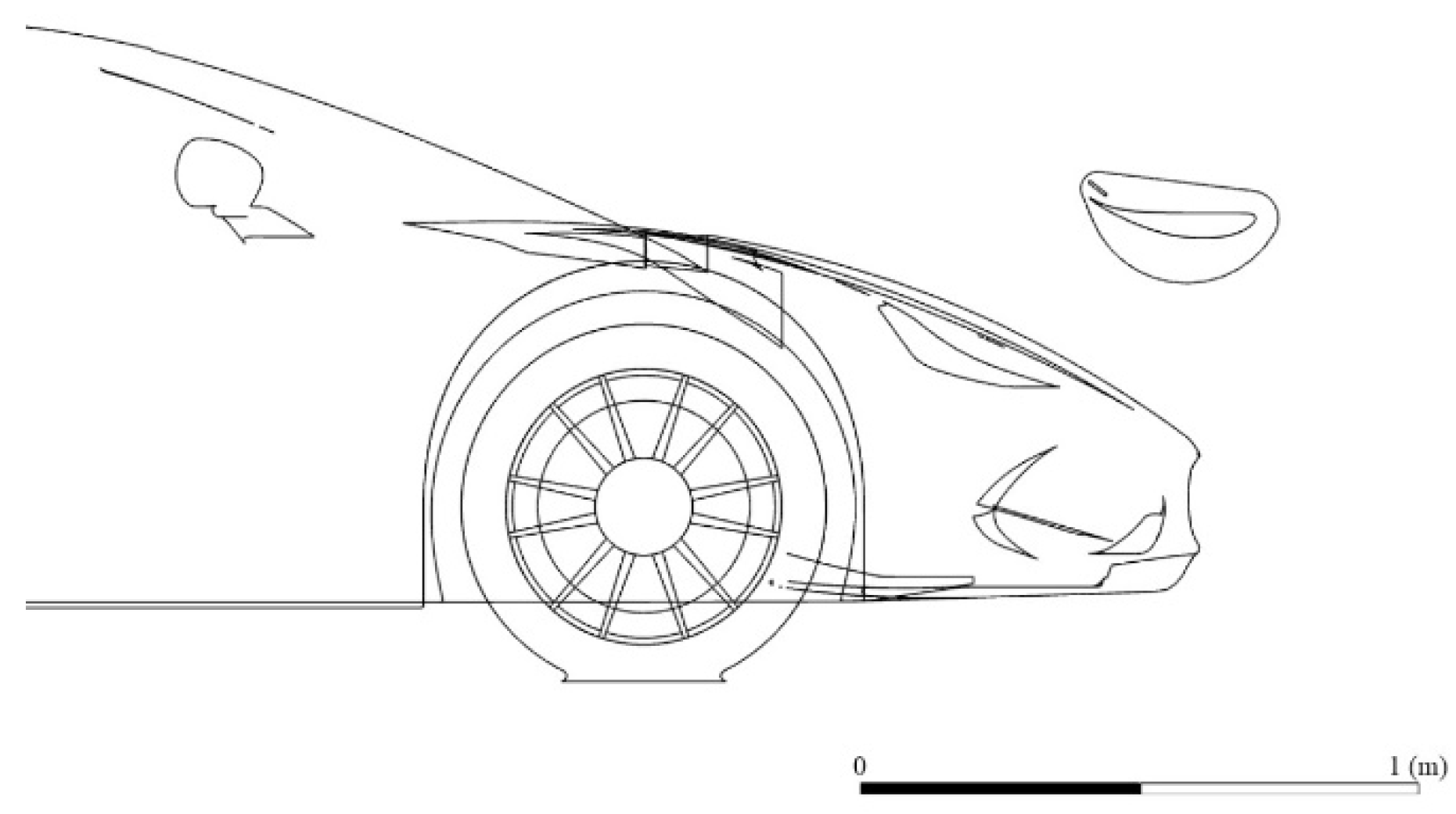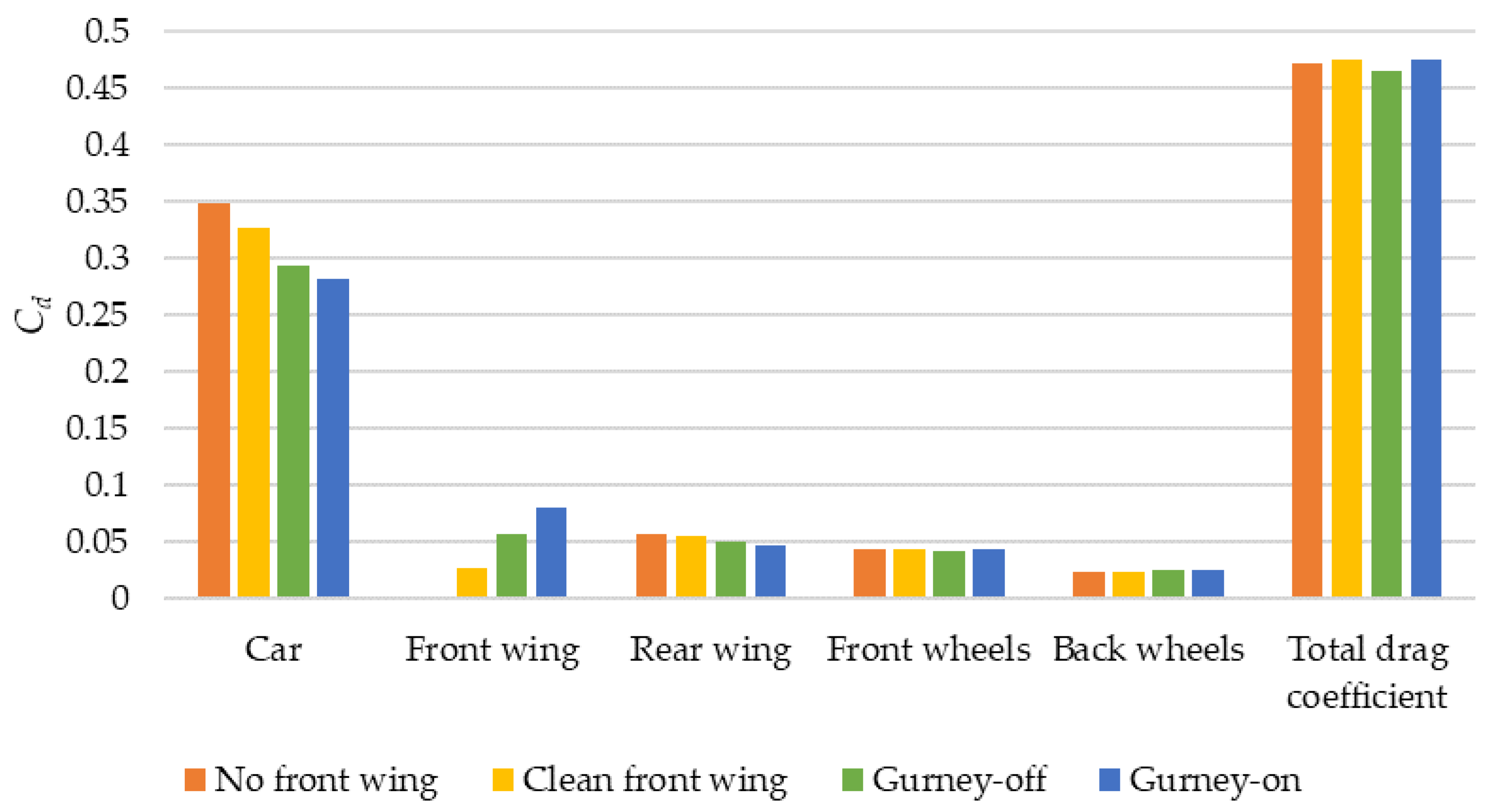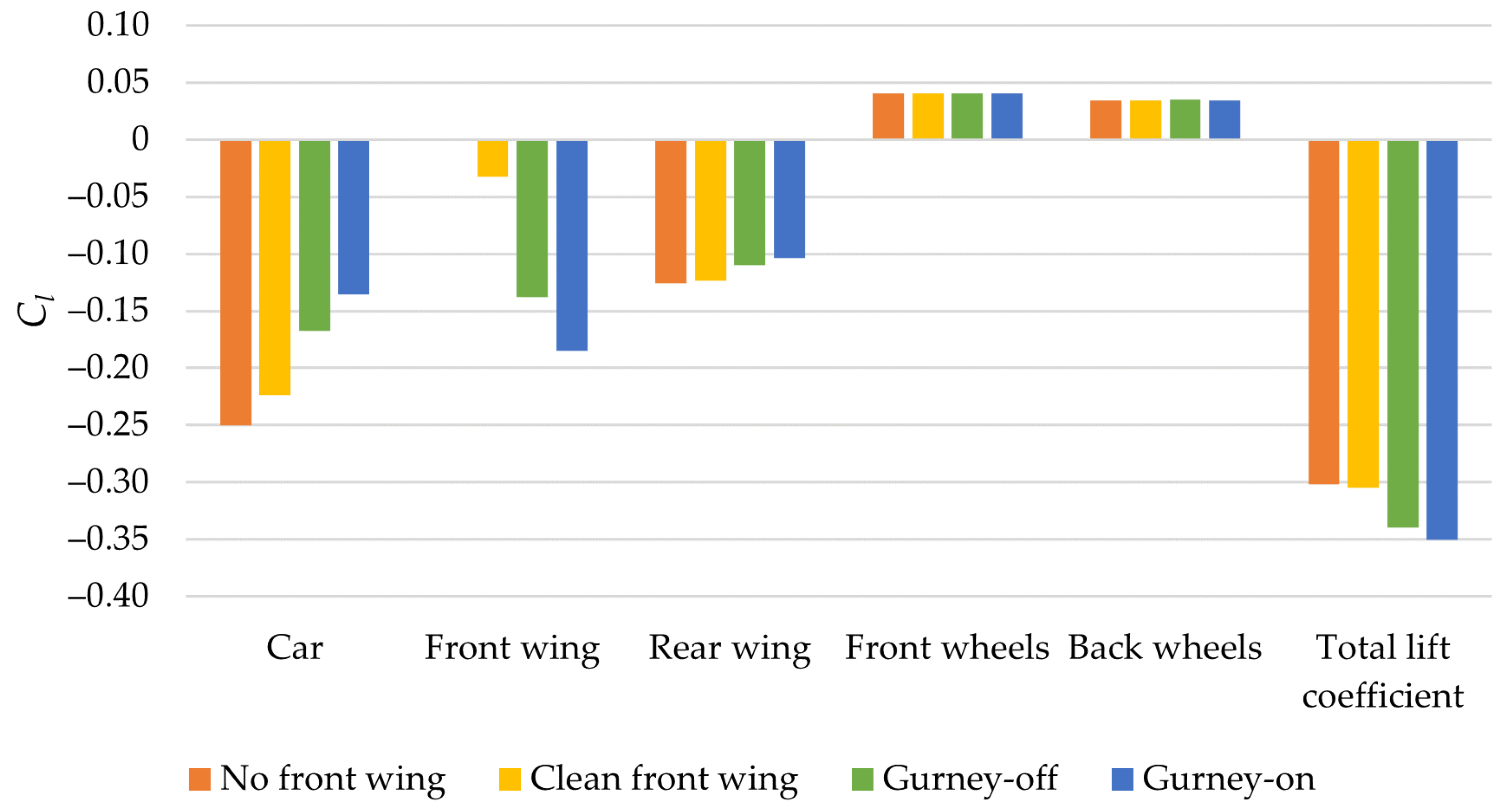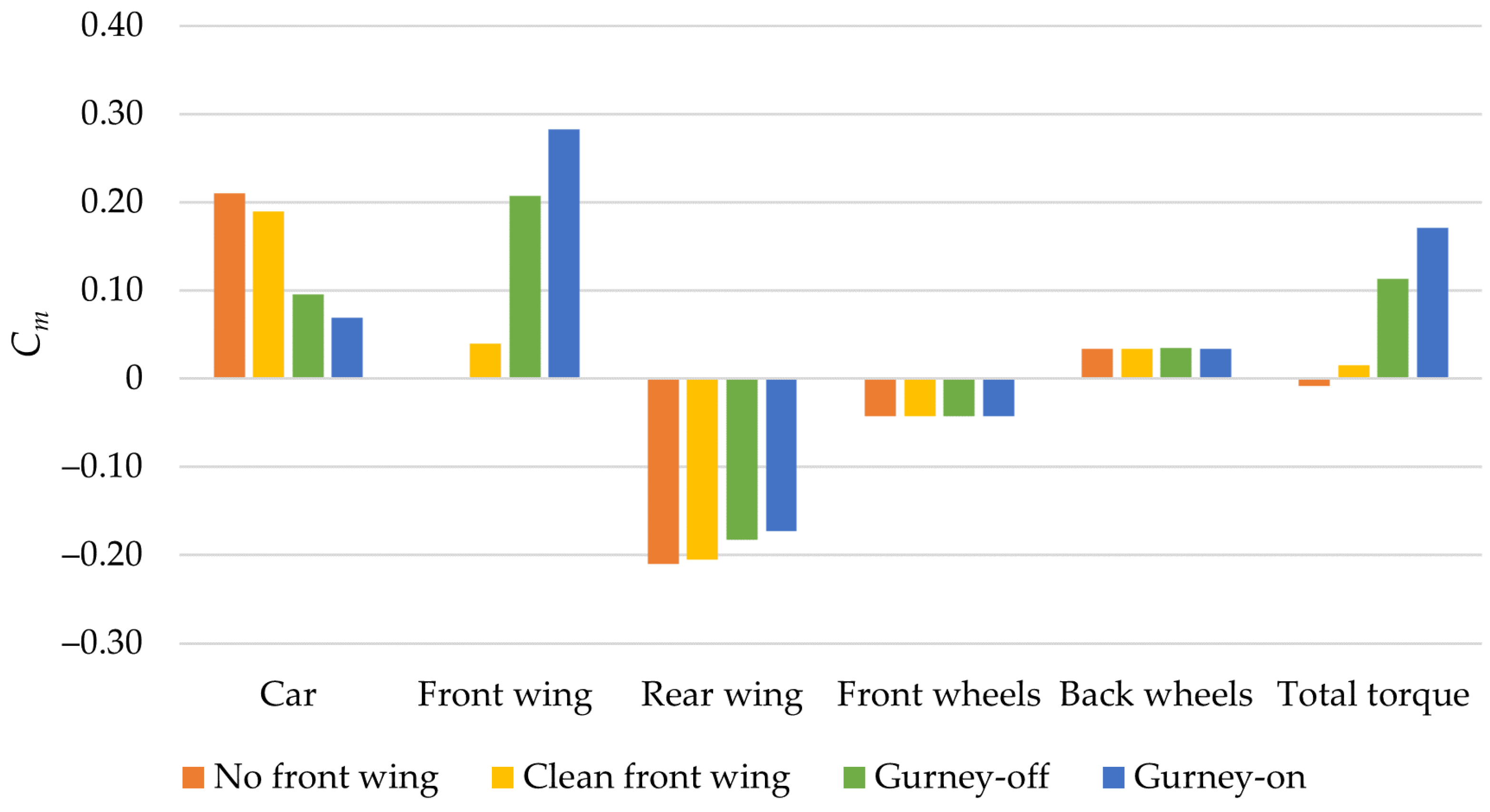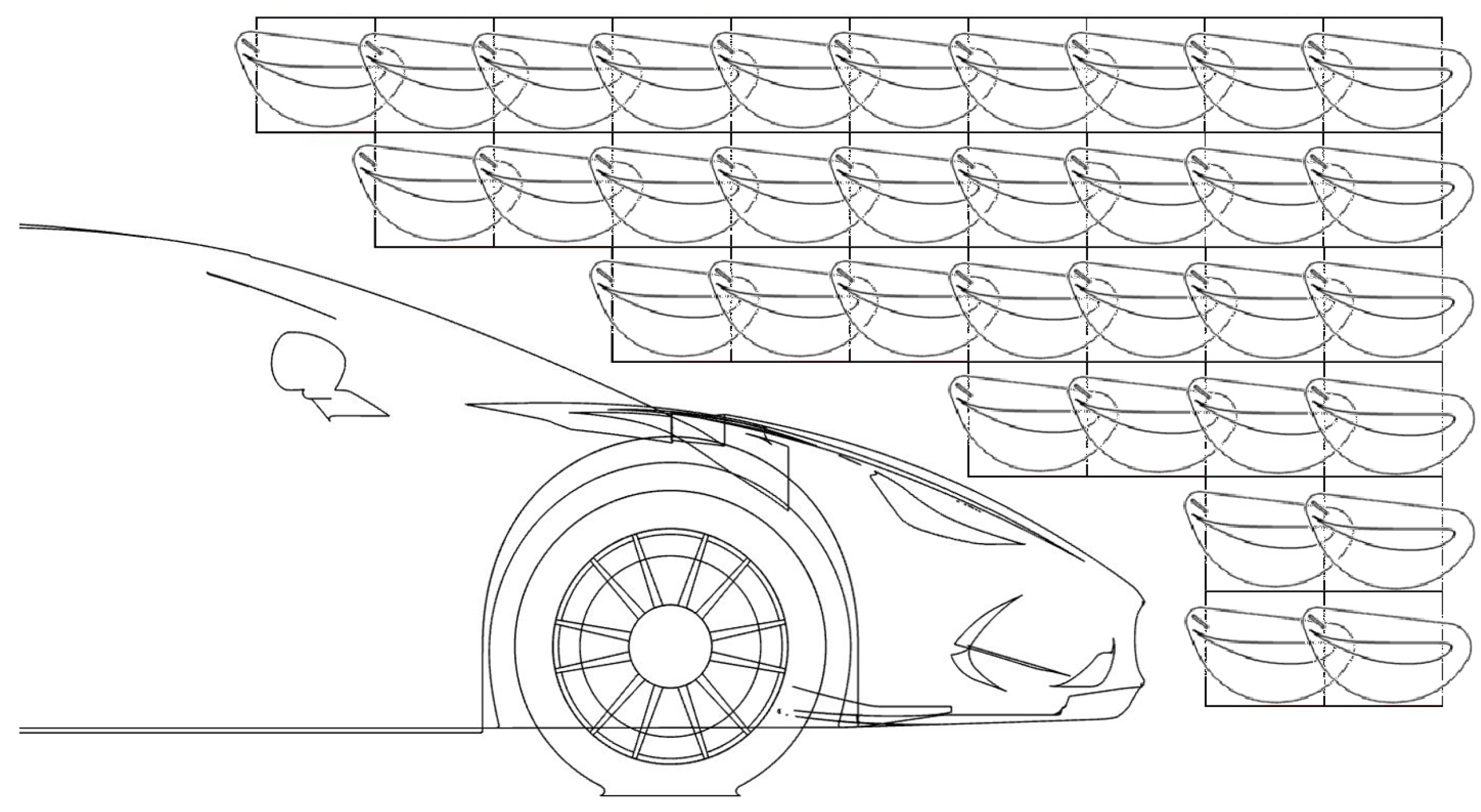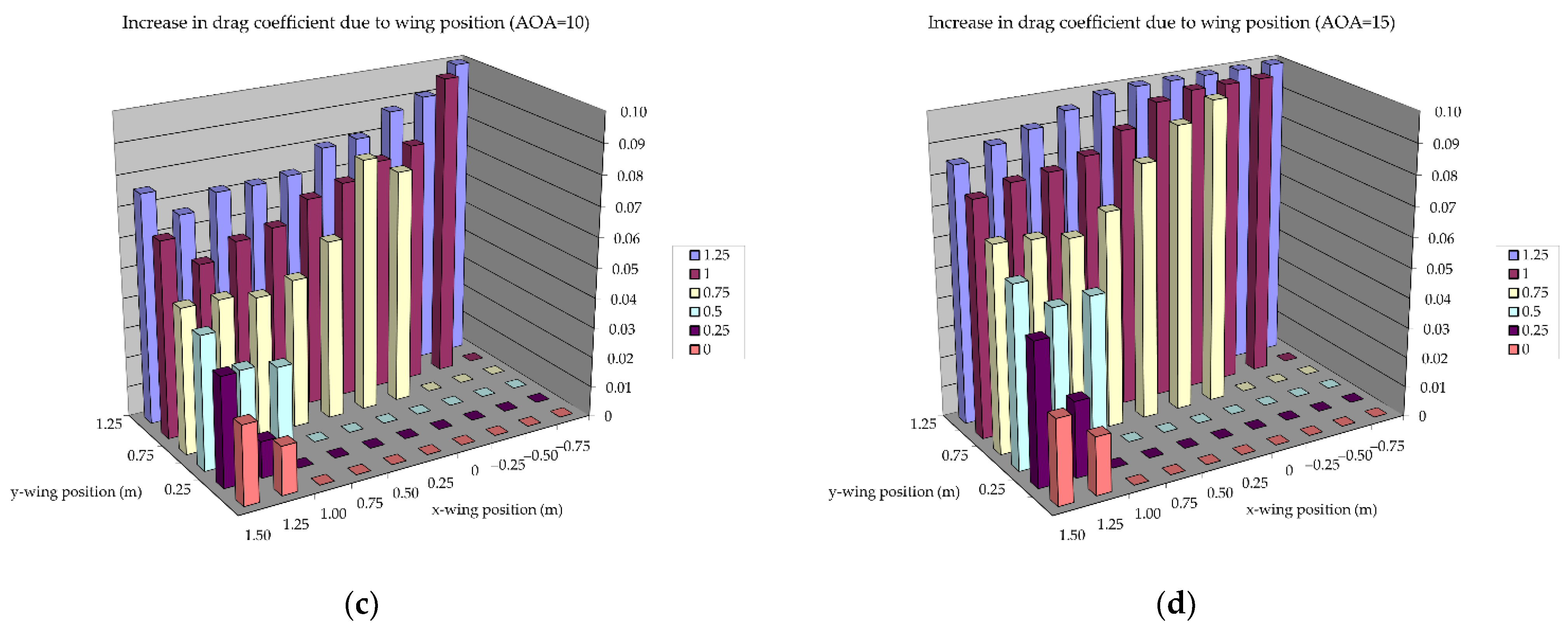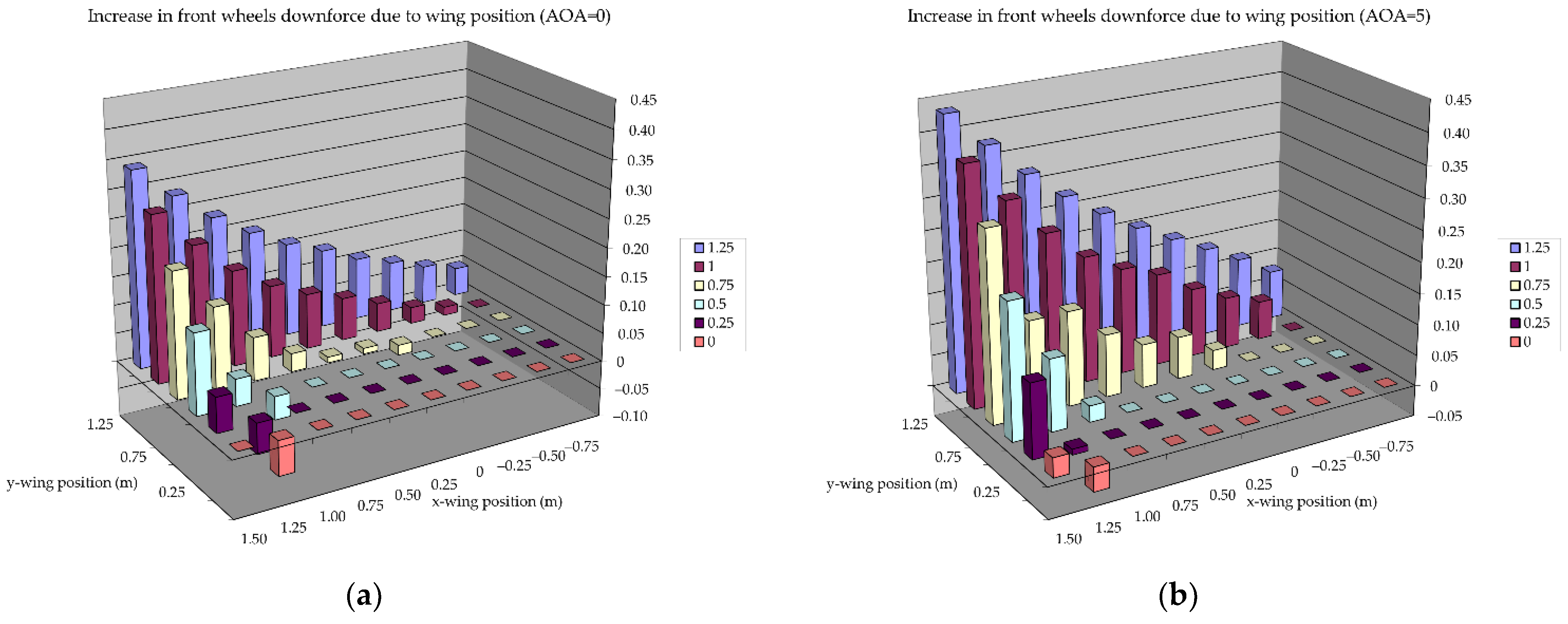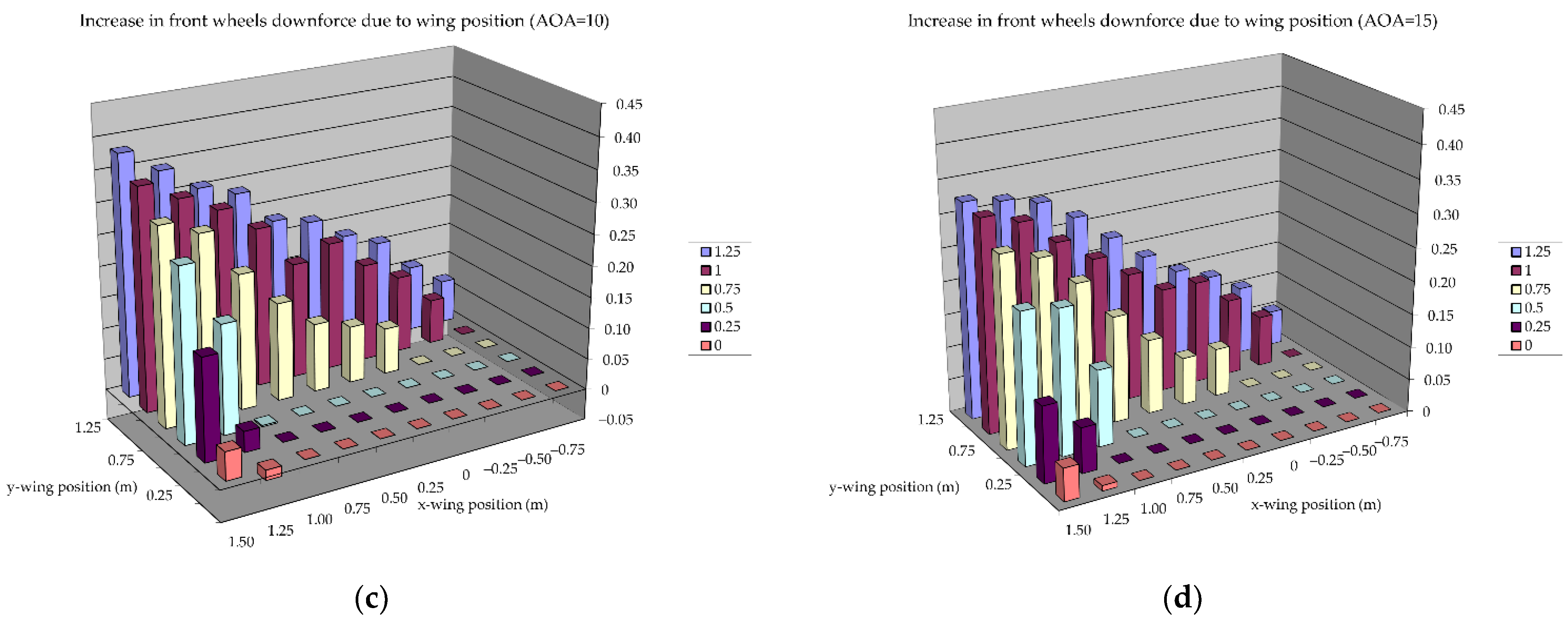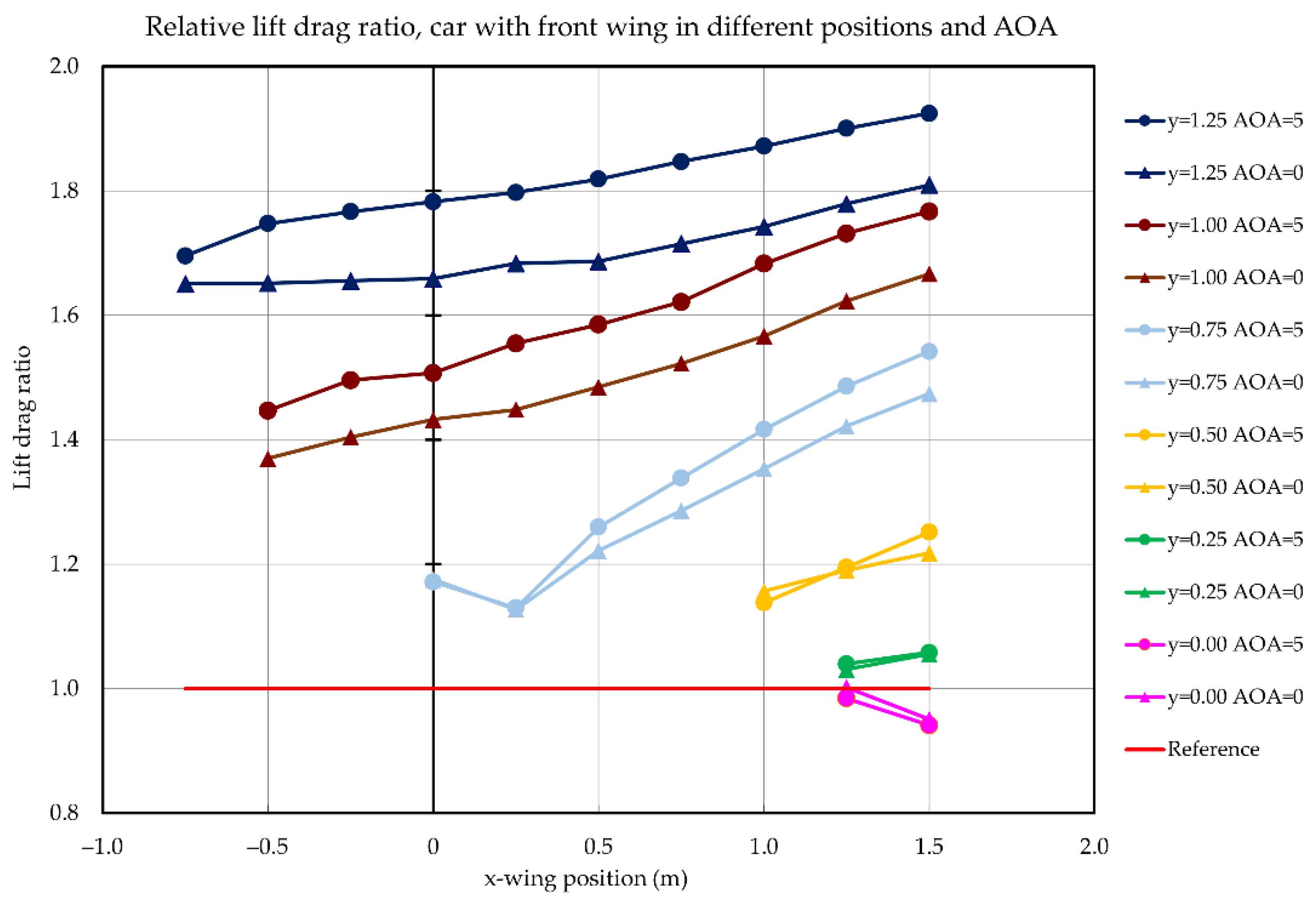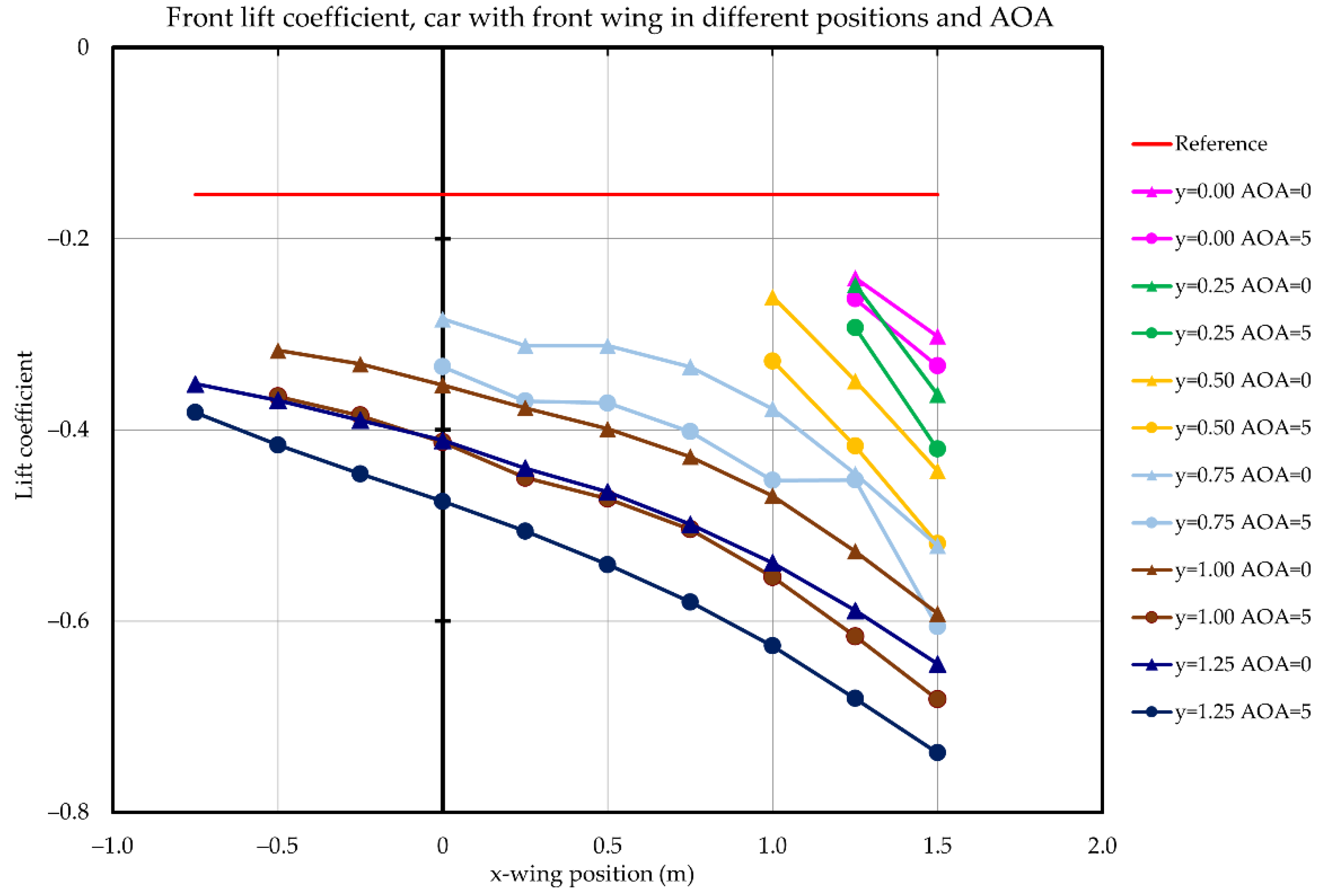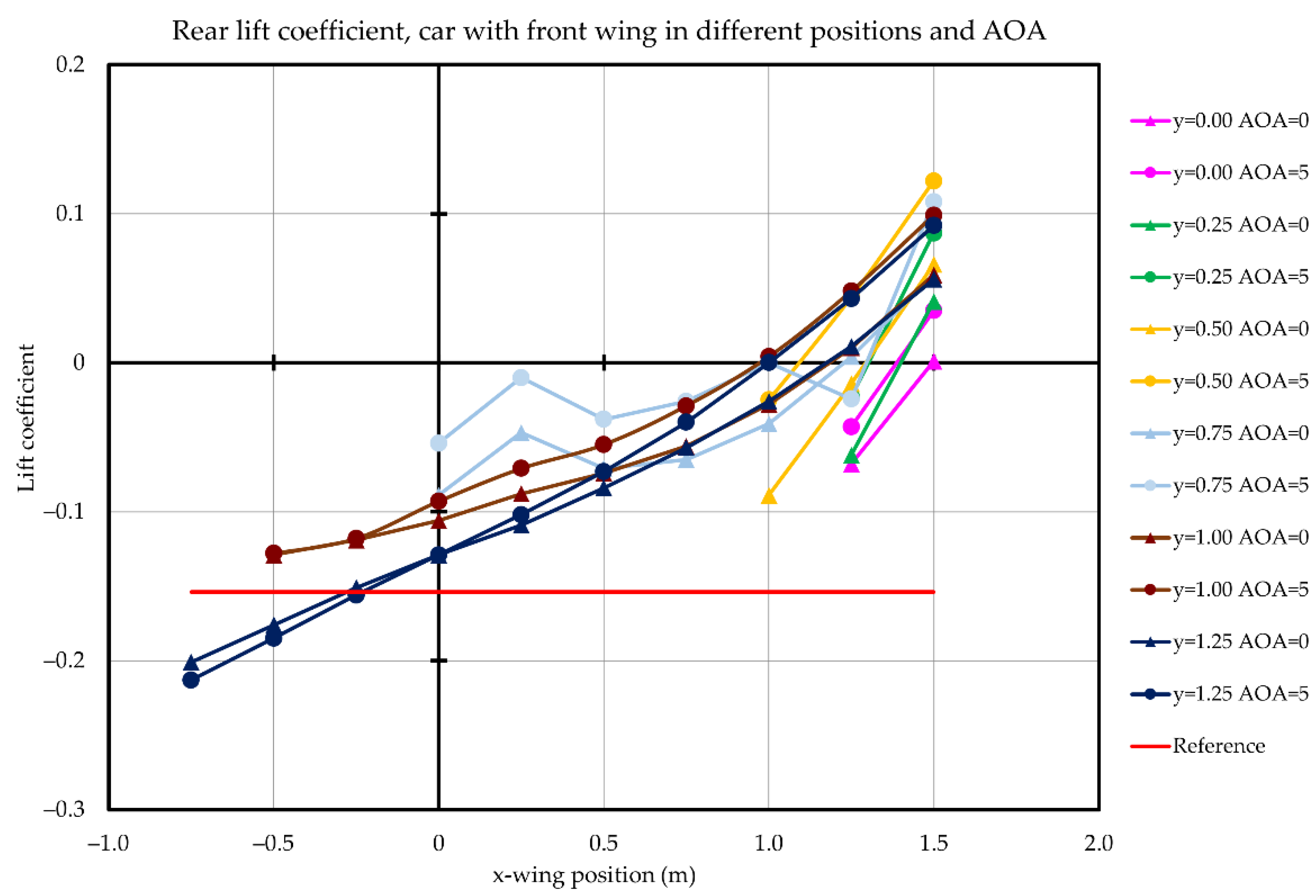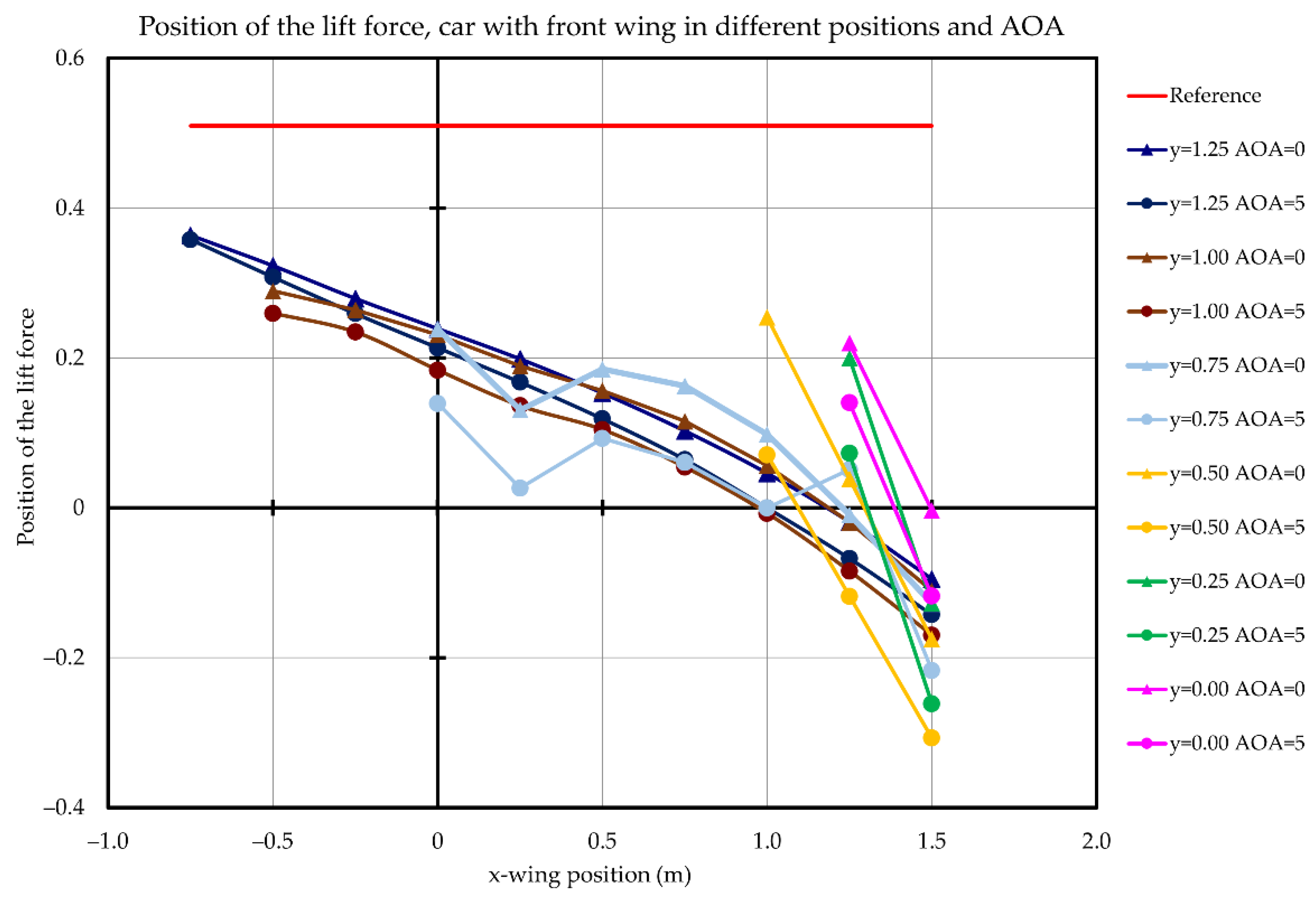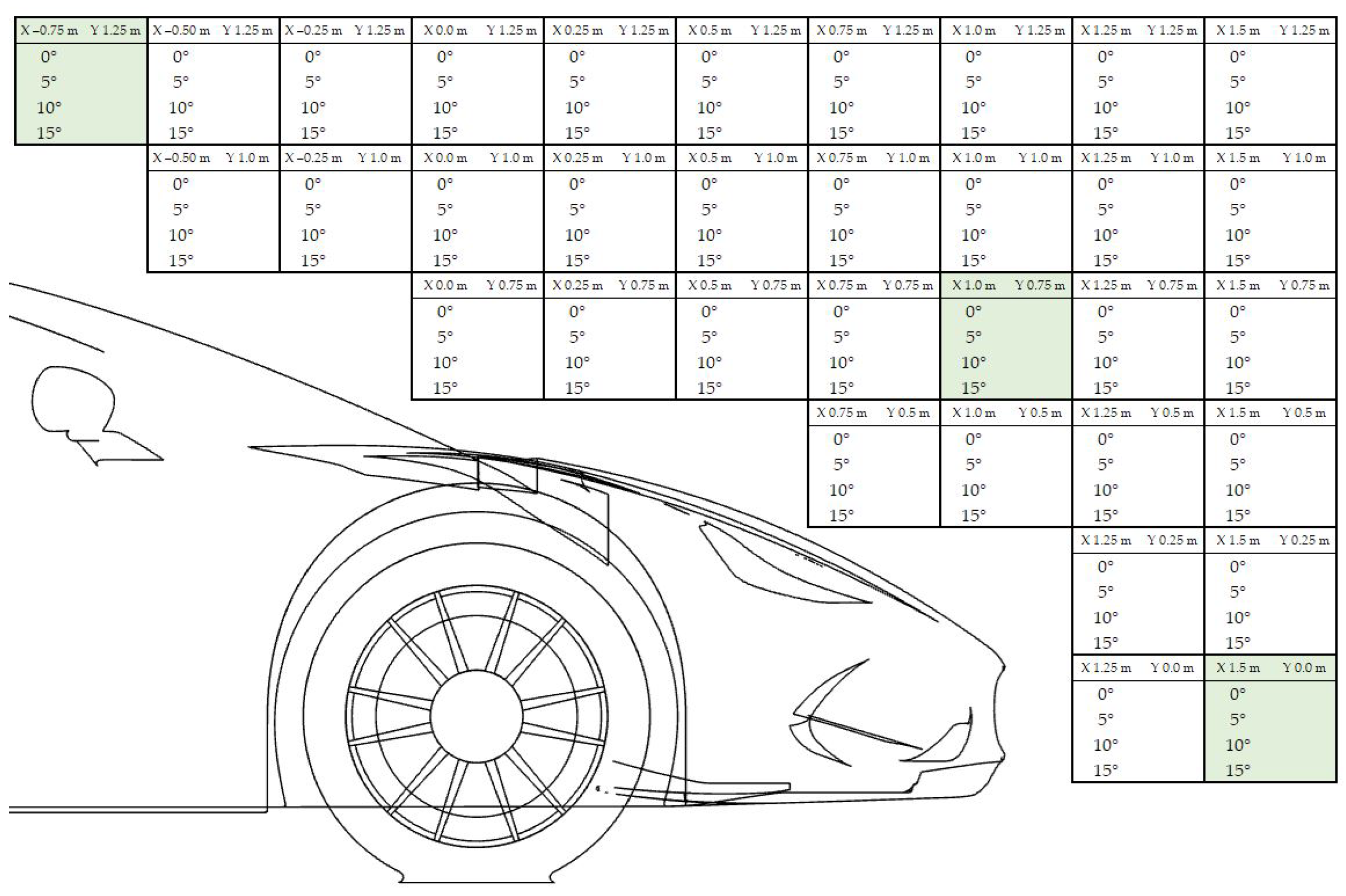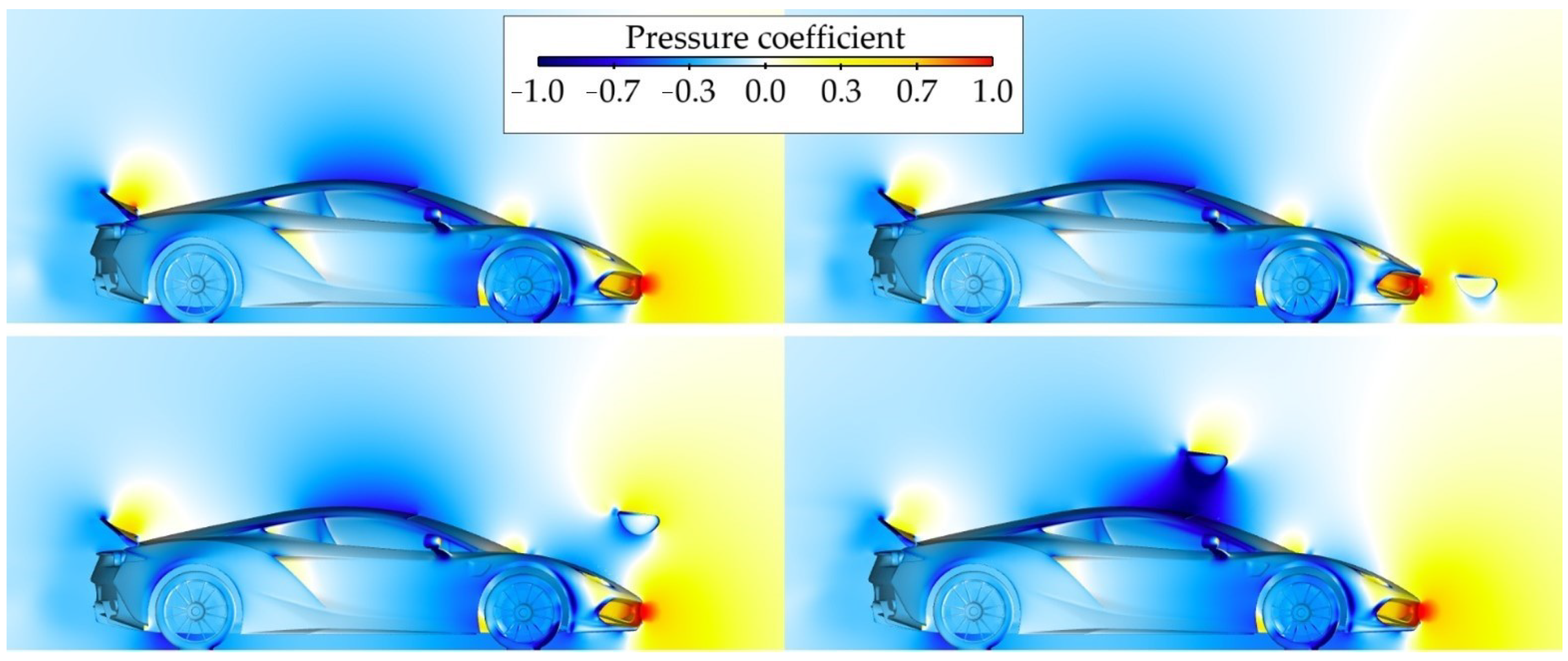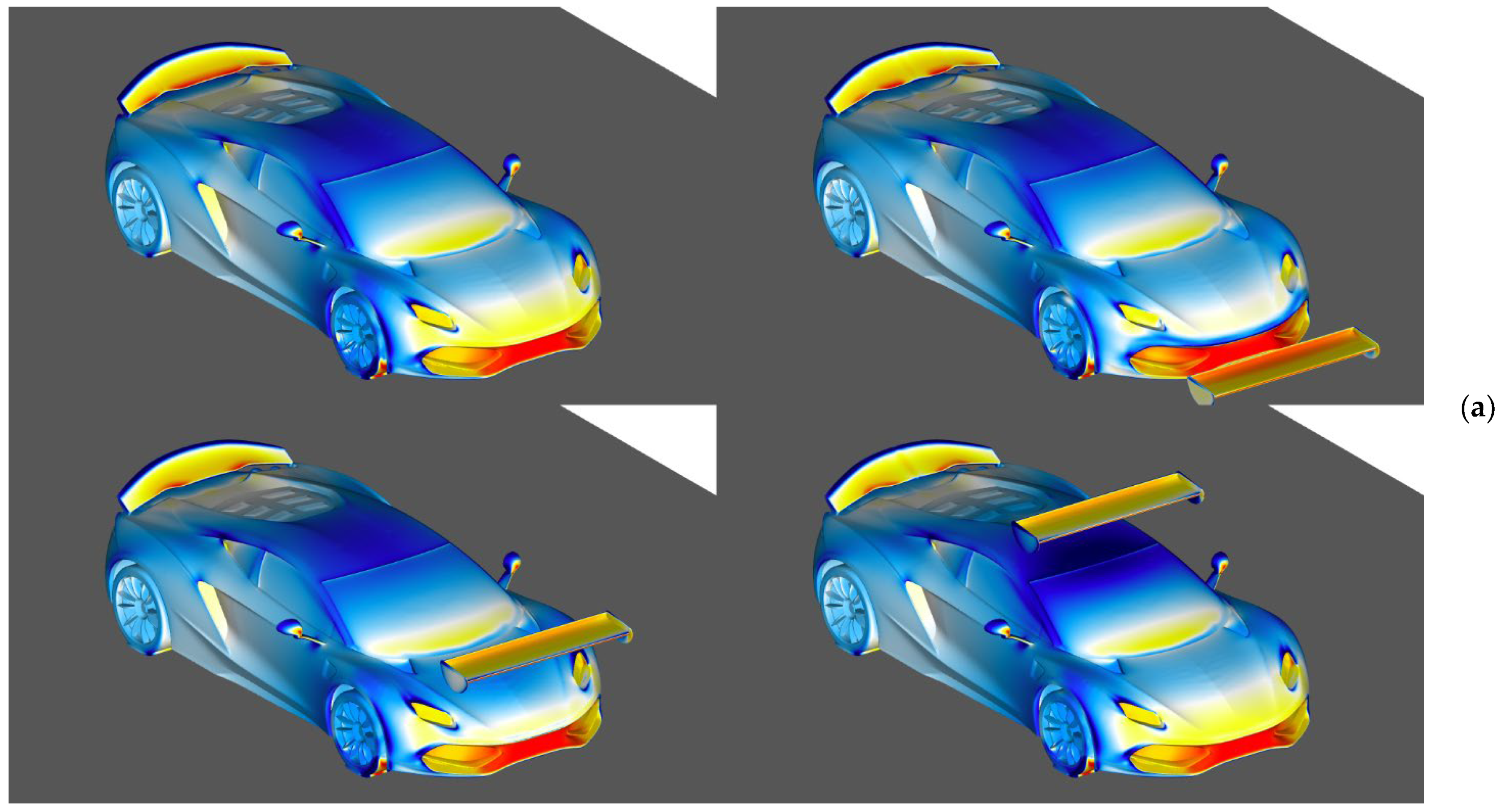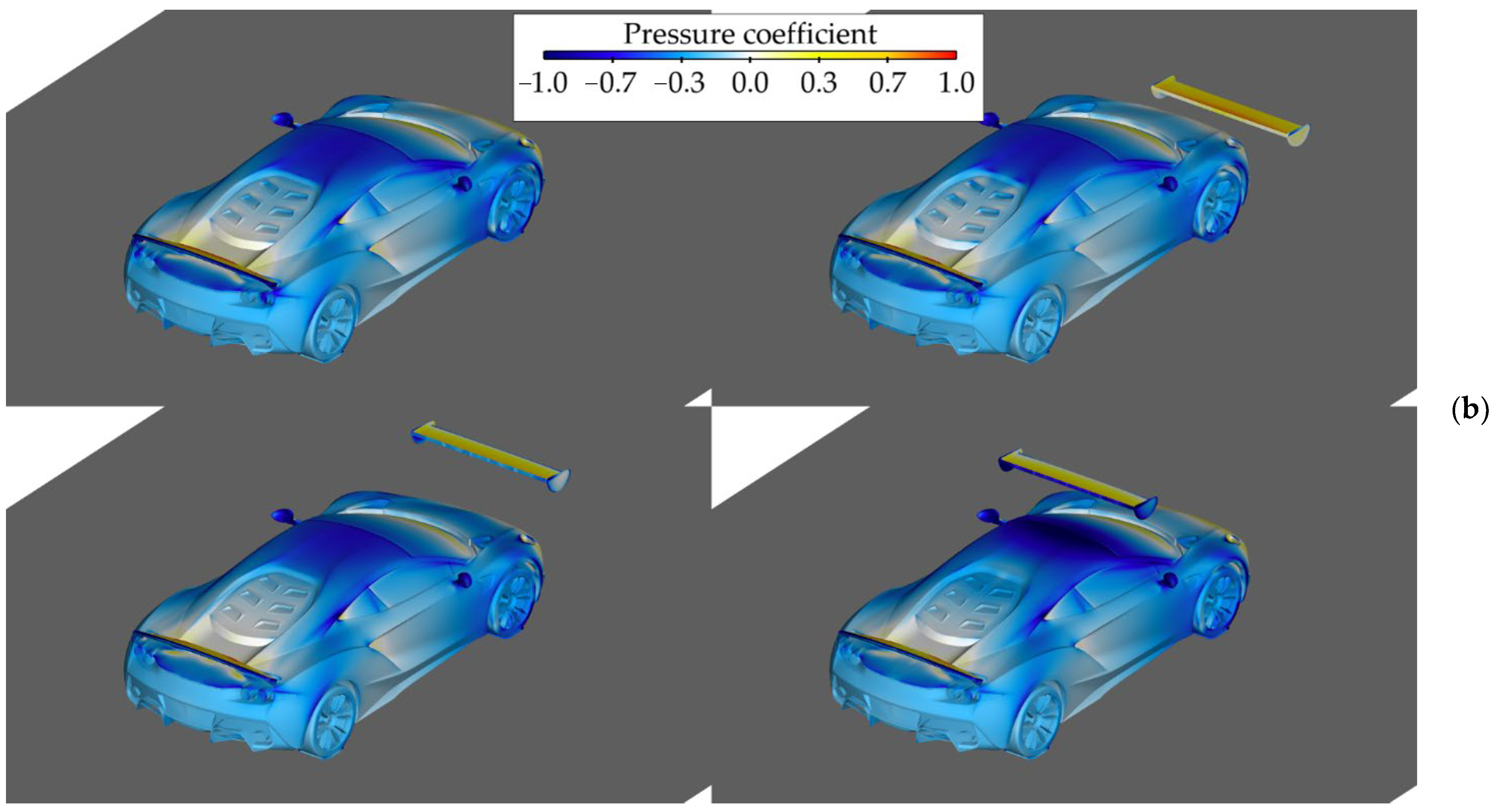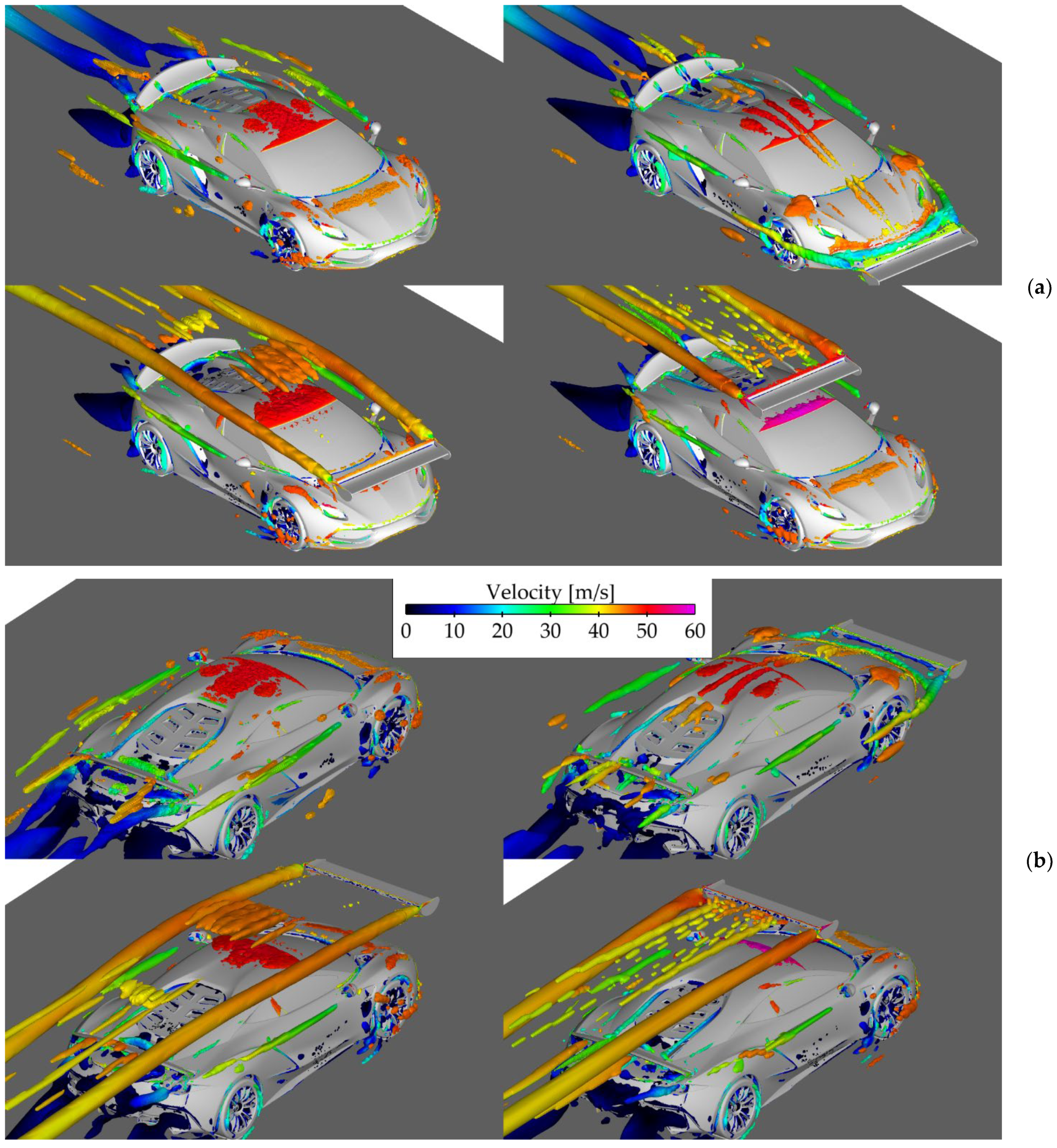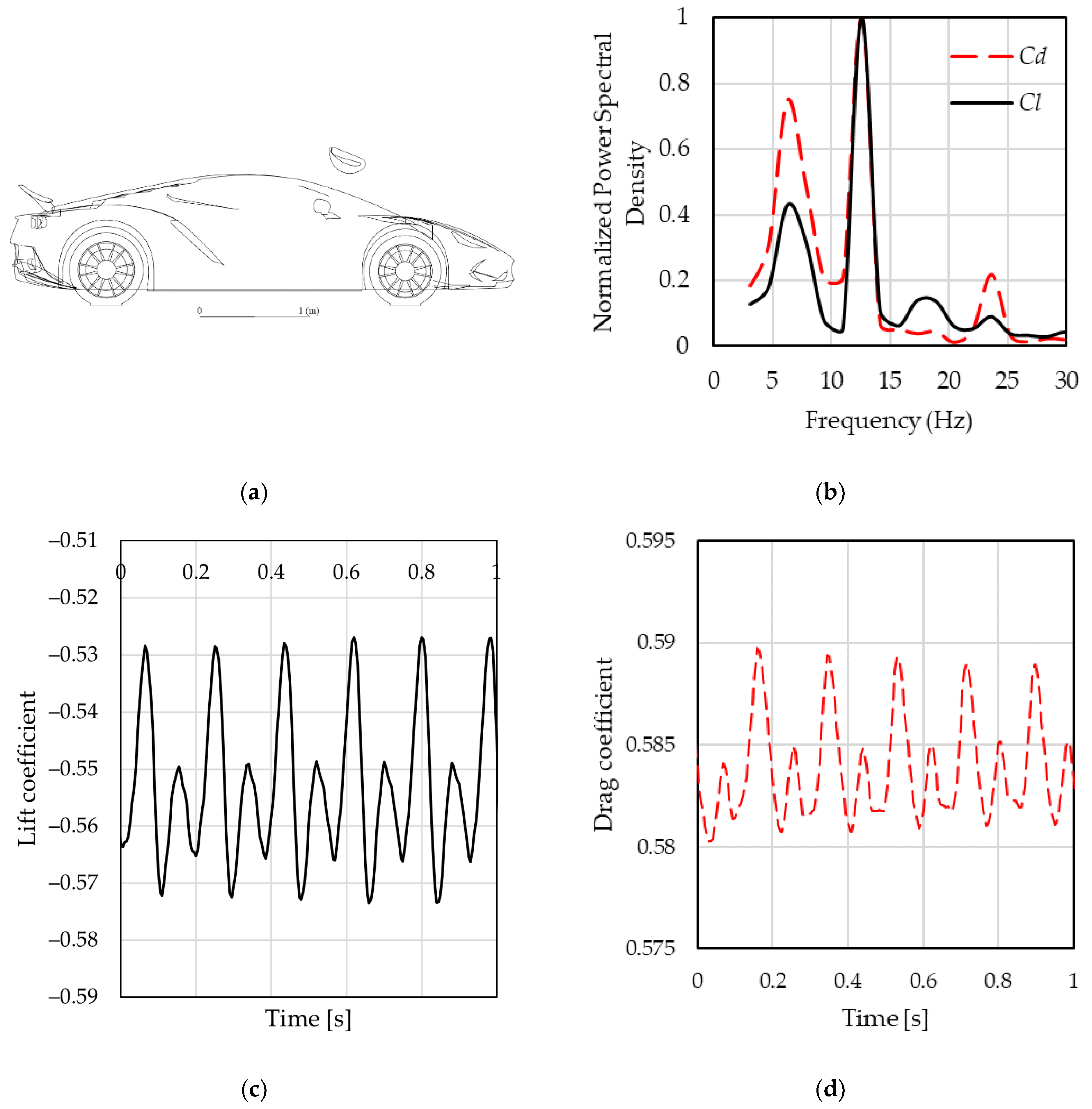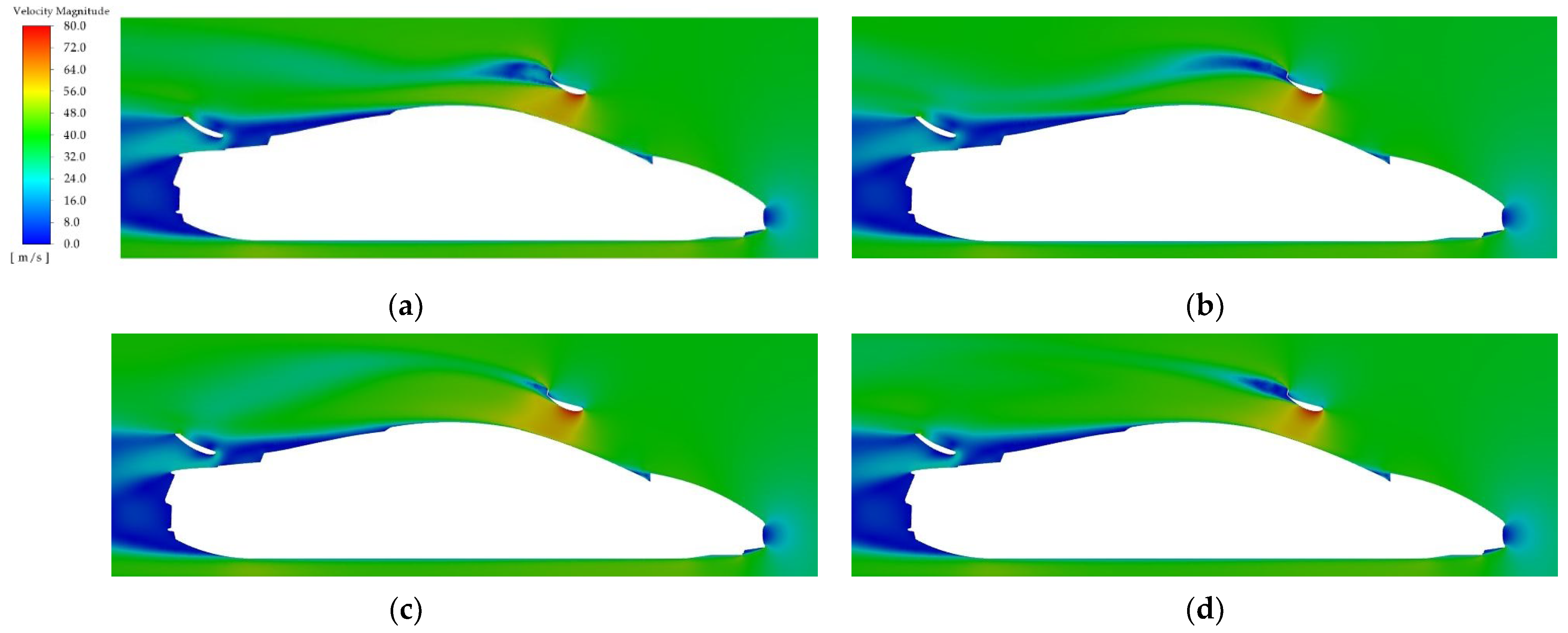1. Introduction
Vehicles are usually equipped with inverted rear wings to compensate for aerodynamic body lift. Sometimes they are so effective that together with the body they generate aerodynamic force, pressing the vehicle against the road.
A lot of work is devoted to rear and front wings on open-wheel vehicles. Front wings have been a feature of open-wheel racing cars since the 1960s. In contrast, front wings are extremely rarely used in motorsports on vehicles with covered wheels. Examples of such unusual features include the Toyota TMG-EV-P002 (
Figure 1) built for mountain racing and some cars used in time attack racing (
Figure 2,
Figure 3 and
Figure 4).
An example is a mountain race held annually named the Pikes Peak International Hill Climb (PPIHC), where cars ascend Pikes Peak in Colorado, USA. The track is 12.42 miles (19.99 km) long with 156 turns, and an elevation difference of 4720 ft (1440 m) from the start at Mile 7 on the Pikes Peak Highway to the finish at 14,115 ft (4302 m), with an average gradient of 7.2%.
To achieve high aerodynamic downforce, mountain racing at relatively high altitudes (2000 m) requires large wing areas to provide downforce. Going uphill with an average gradient of 7% and the need to accelerate after successive turns and brake sharply before the next turns requires a high aerodynamic force on the front wheels.
The sport popularly known as time attack has grown over the last ten years [
1,
2], primarily because of the generally open regulations. According to participants, 60% of the design of very fast time attack cars is influenced by aerodynamic solutions, 20% by the engine and drivetrain, and the remaining 20% by the structural reinforcement used to transfer aerodynamic and drivetrain forces and inertia forces resulting from aerodynamic influence. Aerodynamics in the sport of time attack plays a very big role in this class. The participants create the aerodynamic solutions based on their own knowledge and experience. The powertrains of the cars are very different, including front-drive, rear-drive, and all-wheel-drive systems.
The purpose of this paper is to attempt to explain the complex interactions between a front inverted wing and body flow structure and to help designers use this unusual way of increasing the front axle downforce. While there are many papers devoted to the front wings of cars with exposed wheels, there is only one paper devoted to the front wing for a car with covered wheels [
3].
The main problem arising from the use of wings in the front of vehicle arises from their strong influence on the flow structure over the rest of the vehicle. In the early period of development of open-wheel racing car designs, front wings, usually one- or two-segmented, were fitted to bulky bodies with radiators, along with a central air intake. Further vehicle shapes evolved to reduce the cross-sectional area of the front of the body and to lower it. As the aerodynamic study of racing cars progressed, both experimentally and aerodynamically, the front wings moved away from the narrower front ends of the bodies, moving closer to the roadway.
For racing class cars, regulations have an extremely strong influence on the development of their designs and shapes. Aerodynamic solutions are developed within a strict framework set by the regulations. The regulations, in turn, are based on the conclusions of analyses, mainly track safety analyses and analyses of the attractiveness of the course, usually resulting from overtaking opportunities.
Mountain and time attack races have much more open regulations, allowing for more innovative aerodynamic solutions. For the vehicles used in time attack races, popular sports cars converted for racing are used. Therefore, the bodies themselves are typical and additional aerodynamic components are fitted to them. This makes it significantly more difficult to fit them together.
The typical way to achieve aerodynamic downforce on the front wheels is to use a flat plate called a splitter, placed as close to the ground as possible and located in front of the body. This solution is simple and effective but has a few drawbacks. The most significant disadvantage is the strong dependence of the splitter’s action on the momentary ground clearance values under the plate. In races with rapid braking and acceleration, the use of sprung wheel suspensions causes large changes in the splitter’s momentary distance from the ground. This element located close to the road is very susceptible to damage.
For this reason, other solutions are being sought. One of them involves triangular plates called canards located on the front side surfaces of the body. They generate aerodynamic forces that press the body to the road, and at the same time reduce its aerodynamic resistance. This is a very good solution, although the downforce values achieved are limited by the relatively small size of the tiles.
A drastic solution is to use a wing in front of the body to generate the downforce. In practice, the seemingly effective solution significantly loses its effectiveness due to the interaction between the wing and the body flow structure.
This paper will present the results of numerical analyses of vehicle characteristics with different front wing layouts.
The literature on wings used to generate aerodynamic downforce is extensive but not very related to the problem of front wing interaction with a covered-wheel car, as analyzed in this paper.
There is a large body of work devoted to the aerodynamic characteristics of the wing themselves, and in particular wings placed near the ground.
Knowles et al. [
4] presented an aerodynamic study of a wing operating near the ground.
The studies by Mokhtar [
5,
6,
7] and Mokhtar et al. [
8] presented the results of numerical calculations of the aerodynamic characteristics of wings near the ground, including an inverted wing. Zerihan and Zhan in [
9,
10,
11,
12] presented the experimental results from simple one-element and two-element wings operating near the ground, along with the effects of using a Gurney flap. Ratzenbach et al. [
13] presented the numerical and experimental results for a multi-element wing operating near the ground. Angle et al. [
14] numerically studied the longitudinal stability of a wing with a transverse gap binding the two surfaces of the airfoil. Ahmed et al. [
15] presented the experimental results for a wing placed over a moving wind tunnel floor. Lee et al. [
16,
17] analyzed the effects of distance of an oscillating wing from the ground and the effects of ground undulation on its aerodynamic characteristics. McBeath [
18] has extensively discussed the use of a front wing with multi-element airfoils, Gurney flaps, and edge plates.
Many studies are available in the literature on the interactions of wings placed low to the ground with uncovered wheels behind them. Most of the articles are related to Formula 1 cars.
The study by Basso et al. [
19] presented an analysis of the interaction of a front wing with a Gurney flap on the components of a Formula 1 car. Some of these studies, such as the study by Roberts et al. [
20], have dealt with the operation of a front wing during curved or slanted inflow. Katz [
21] presented a model for the generation of aerodynamic downforce caused by the interaction of the front and rear wings with the exposed wheels of a car based on the panel method. Katz [
22] presented an analysis of front wing performance near the ground and the effect of a Gurney flap. Martins et al. [
23] studied the effect of the slender fuselage of a car with a flap on the pressure distribution in the wake behind the uncovered wheel behind it. Diasinos et al. [
24] studied the effect of wing span on the aerodynamic characteristics near the ground. The studies by Diasinos et al. [
25,
26] presented problems involving front wing interactions with exposed wheels. Ogawa et al. [
27] presented problems and solutions related to the integration of a front wing with the wheels and body of an F1 vehicle. Correia et al. [
28] presented the scale effect on the aerodynamic characteristics of a single-element inverted wing in terms of ground effects.
There are quite a few studies on the interactions of rear wings with cars with shielded wheels. The classic study is that by Katz et al. [
29], in which the interaction of a rear wing with a body with covered wheels and long diffuser channels is presented. Gogal and Sakurai [
30] demonstrated the effects of rear wing end plates on performance under oblique inflow. Kurec et al. [
31] presented the impact of the position of the rear wing on the aerodynamic loading on both axles of a car with covered wheels, along with changes in braking performance. Broniszewski and Piechna [
32] presented a coupled simulation of car dynamics and aerodynamics with a movable rear wing.
The only paper devoted to the interaction of the front wing with the body of a car with covered wheels is that by Piechna et al. [
3], in which the strong interaction of the front wing on the pressure distributions on the body of the car and the reduction of its effectiveness are shown.
2. Materials and Methods
The analyzed geometry was for an Arrinera Hussarya Polish supercar (manufacturer Arrinera Automotive S.A. based in Warsaw, Poland), with a moderate rear spoiler and without a splitter. At the rear of the plain underside, there is a moderate diffuser. Details of the wheels and mirrors were modelled. The idea was to analyze the configurations of front wings in a realistic context, whereby the main features affecting the car’s aerodynamics would be presented. The geometry is shown in
Figure 5.
Two wing types, shown in
Figure 6, were used in the study, namely a clean wing and a wing with a Gurney flap, which could be turned on or off.
The front wing needs to be attached to the main car body with an appropriate structure. The structure itself may alter the car’s aerodynamic performance. However, there are numerous possible configurations for attaching the front wing to the car, as shown in
Figure 2,
Figure 3 and
Figure 4. In some cases, it may be possible to modify the front of the car and hide the front wing in the body outline. For this reason, the modelling of wing supports was neglected.
Lift and drag coefficients Cl and Cd are defined as forces divided by ½ρv2A, where reference values of density ρ = 1.225 kg/m3, velocity v = 40 m/s, and the area of A = 0.9879 m2 are used. The area corresponds to the projected front area of a symmetric half of the car.
The pitching moment was computed along an axis placed in the middle of the distance between car axles. The distance between the axles was 2.655 m. The positive moment coefficient indicates the downforce on the front axle. The moment coefficient is calculated as:
where in the studied case
rr = rf = 1.3275 m, which is nondimensionalized by (
rr + rf).
Clf and
Clr are lift coefficients at the front and rear axles, respectively:
Front wing positions are referenced to the coordinate system anchored at the front axle of the car. The computational domain dimensions are shown in
Figure 7 and
Figure 8.
Individual meshes for the car body and front wing were generated and later superimposed on each other. The overset mesh interface [
33] connected fluid zones by interpolating cell data in the overlapping regions. The advantage of such an approach was that the front wing mesh could be freely translated and rotated in the domain. Because of the significant number of studied wing positions, the overset mesh method significantly reduced the model preparation time.
Meshes were generated in Fluent Meshing 2021R2. A relatively uniform surface mesh was applied to the car body and one box-shaped body of influence (BOI) was added. The poly-hexcore algorithm was chosen for the volume mesh and polyhedral cells were placed between hexcore layers to avoid 1/8 volume transition. The cell size of the front wing mesh was selected to match the size of the background mesh of the car domain.
The boundary layer mesh was designed to fit the wall function approach. The boundary layer mesh consisted of 5 elements, with a growth rate of 1.2 and a constant first layer height of 1.3 mm on the car body to achieve y+ in the range of the logarithmic layer. At ground level, an aspect ratio method was chosen with 5 layers, a growth rate of 1.2, and an aspect ratio for the first element of 10.
Grid sensitivity was assessed by changing two parameters: the size of the body of influence and the mesh density in this region.
Table 1 lists the selected body of influence dimensions, which are also shown in
Figure 9. Three body of influence sizes were prepared and for each of them three gradually refined meshes with a refinement factor of 1.3 and with the same topology were studied. The local cell size in the proximity of the car was defined as the characteristic cell size
h. This corresponds to
hcoarse = 0.04 m,
hmedium = 0.031 m, and
hfine = 0.024 m. For each of the nine studied meshes, the maximal inverse orthogonal quality did not exceed 0.9, indicating very good grid quality.
The results of the grid sensitivity test [
34] are shown in
Figure 10 and
Table 2. The sensitivity of the drag coefficient
Cd to the grid size was found to be small, with a total spread of 2.6%. The difference between BOI sizes 2 and 3 was smaller than 0.1% for medium and fine grids, which can serve as an argument that a BOI of size 2 is sufficient. The relative difference in the drag coefficient between medium and fine grids was 0.5%. Similar observations can be made when analyzing the results concerning lift coefficient
Cl, where the total spread was 6.2% and the relative difference between BOI sizes 2 and 3 was 1% for medium and fine grids. The relative difference in the lift coefficient between medium and fine grids was smaller than 0.5%. Taking all of the results into account, the medium grid with a BOI of size 2 was selected for further study as a compromise between computational effort and accuracy (
Figure 11).
The numerical model was prepared with the use of ANSYS Fluent 2021R2 software. A pressure-based solver, implicit formulation, and least squares cell-based option for the calculation of gradients were chosen for all the studied cases. The coupled pseudo-transient scheme was applied for pressure–velocity coupling. Second-order spatial discretization was set for pressure and momentum. A steady-state Reynolds-averaged Navier–Stokes k-epsilon realizable turbulence model with enhanced wall treatment and a production limiter was selected. The achieved Y+ on the vehicle body had an average of 55 and maximum of 190.
The inlet velocity was 40 m/s, with a turbulence intensity 5% and length scale of 5 mm. Moving wall boundary condition was applied to the ground and car wheels. Half of the geometry was modelled with a symmetry boundary condition. The same boundary condition was also applied to the side and top surfaces.
Forces and moments acting on the car were monitored throughout the iterative calculation process. Iterative calculations were run until 8–10 periods of stable oscillations in observed values were captured. It was verified that the convergence error did not exceed the discretization error and that the steady-state results were in line with averaged transient results.
4. Conclusions
This paper presents an analysis of the effects of the front wing position on the aerodynamic characteristics of a sports car. The initially aerodynamically balanced load distribution of both axes of the vehicle changed tremendously after the front wing was added, depending on its front position and wedge angle. The vehicle began to oversteer as the car in this configuration was unstable. There was a very strong coupling between the flow around the front wing itself and the flow around the vehicle body.
The use of the wing at the front of the vehicle led to a decrease in the aerodynamic downforce of the vehicle itself, which reduced the effectiveness of the wing action. The front wing in any configuration generated aerodynamic downforce, but at the same time modified the body flow structure in such a way that it lowered the downforce generated by the body. The forces on both elements occur partially compensated for each other.
Changing the direction of the airflow under the wing caused by the body flow structure changed the angle of the actual airflow on the wing, causing changes in the angle of attack and aerodynamic downforce in certain positions above the body. It follows that their effects cannot be summed up when tested separately. Thus, by using the front wing we can increase the driving, braking, and lateral forces on the front axle on the one hand, although the vehicle becomes unstable on the other. It becomes obvious that it is necessary to use an effective wing system in the rear part of the vehicle to restore the aerodynamic balance and obtain neutral characteristics of the vehicle.
The use of front wings in specific configurations seems to be the orthodox solution, although various aspects of their use must be considered. Changes in aerodynamic drag resulting from the use of a front wing can be up to 20% of the drag of the vehicle itself. The incremental aerodynamic downforce of the front axle is much greater. In any case, the use of a front wing increases the aerodynamic downforce of the front axle of the vehicle but disturbs the balance and must be accompanied by the use of a corresponding rear wing.
Thus, using the information presented in this work, it is necessary to analyze the flow around the entire vehicle, with the front wing and rear wing aerodynamically balancing the vehicle. Because the downforce on the front axle increases rapidly when elevating the front wing position, it may be necessary to use a smaller front wing to achieve aerodynamic balance. This may be the subject of future work.
